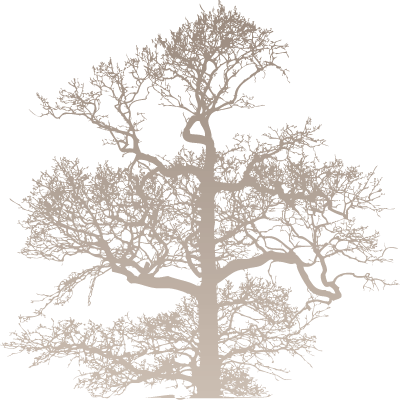Byzantine Catholic
Pittsburgh, Allegheny County, Pennsylvania
Pottstown, Chester County, Pennsylvania
Hawk Run, Clearfield County, Pennsylvania
Hazleton, Luzerne County, Pennsylvania
Lansford, Carbon County, Pennsylvania
Freeland, Luzerne County, Pennsylvania
Kingston, Pennsylvania
Latrobe, Westmoreland County, Pennsylvania
Homer City, Indiana County, Pennsylvania
Allentown, Lehigh County, Pennsylvania
Pittston, Luzerne County, Pennsylvania
Old Forge, Lackawanna County, Pennsylvania
Pocono Summit, Monroe County, Pennsylvania
Braddock, Allegheny County, Pennsylvania
Lopez, Sullivan County, Pennsylvania
Palmerton, Carbon County, Pennsylvania
Orthodox
Old Forge, Lackawanna County, Pennsylvania
Byzantine Catholic
Holy Spirit Byzantine Catholic Church
Pittsburgh, Allegheny County, Pennsylvania
Photo - Holy Spirit Facebook Page
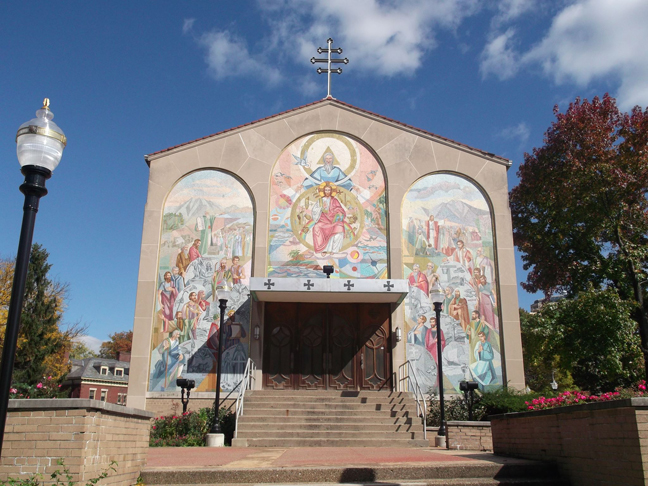
Greek Catholics began arriving in Pittsburgh during the turn of the century. On June 8, 1907 a committee was formed by Father John M. Szabo to organize a parish. A vacant church at Bates and Atwood Streets was located. Devout Greek Catholics raised funds and in a very short time, a $3,000.00 deposit was collected. The total cost of the new church was $10,000 and it was named Holy Spirit Greek Catholic Church. Father Szabo would be the first priest to serve. After cleaning and decorating, the first Mass was held on June 14, 1907. After Father Szabo, Father Michael Balogh was assigned to the new church. The beginning, like so many other Greek Catholic churches during this period, had trials. Bishop Stephen Ortynsky had arrived in the United States and transferred Father Balogh. A committee went to see the new bishop to request a new priest. However, when the membership refused to turn over the deed to their church, Bishop Ortynsky refused to assign a new pastor.
Original church on Bates and Atwood Streets
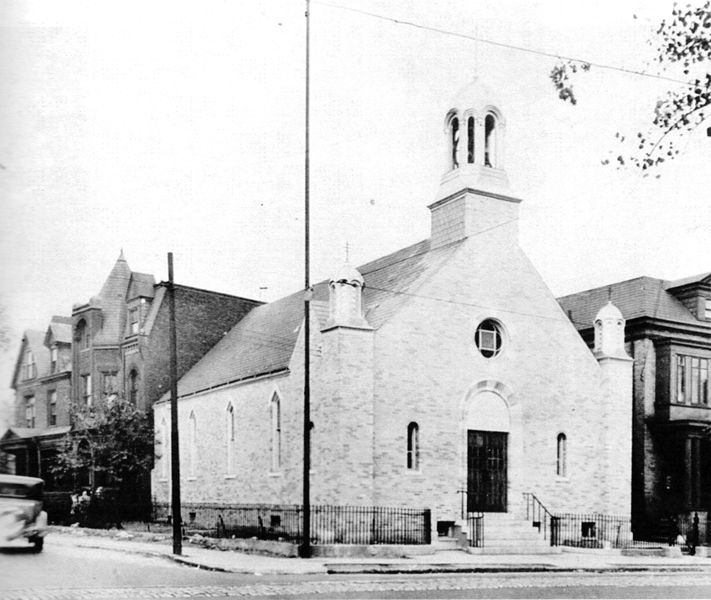
Having no other recourse, they requested an audience with the Roman Catholic (later Archbishop) of Pittsburgh, Bishop John Canevin. Bishop Canevin was sincerely touched by their plea for a new pastor so they would not be without the comfort of their Catholic faith and gladly assisted in the appointment of Father Anthony Kecskes from McKees Rocks. Later, it was learned Father Theodosius Vasochik became available while he was residing in Olyphant, Pennsylvania. Father Vasochik met with Bishop Canevin and was assigned as pastor of Holy Spirit Church. Father Vasochik, who was ordained in 1902, had received his theological education and Doctoral Degree in Sacred Theology from the University of Budapest, Hungary. His appointment turned into a blessing and he would serve Holy Spirit for 43 years until his death in 1950.
With the hard working parishioners and Father Vasochik guiding them, the new church expanded at a rapid pace. A rectory was constructed in 1909, more property was purchased and the entire church exterior was remodeled in 1928. Bishop Basil Takach had been sent as the first Bishop for Ruthenian Greek Catholics and resided in Pittsburgh. Holy Spirit no longer was concerned who was in charge of their parish as they now had their own bishop. Father Vasochik, along with the faithful, worked enthusiastically to expand their church which was constantly growing. In 1948, Father Vasochik’s health began to fail and it was difficult for him to manage such a large congregation. Bishop Daniel Ivancho, the second Bishop of Pittsburgh, assigned Father Paul Shogan to serve as assistant priest to Father Vasochik.
Not long after, Father Michael J. Dudick, who later was the second Byzantine Catholic Bishop of Passaic, New Jersey, came to Holy Spirit and assisted Father Vasochik. It is noteworthy by February of 1949, Holy Spirit voted to adopt the Gregorian calendar and forgo the old Julian calendar. This was taking place in the majority of Greek (Byzantine) Catholic Churches in the United States. On September 18, 1950, Father Vasochik died and Father Michael Pipik was assigned as the new pastor of Holy Spirit. Father Pipik organized the Ladies’ Altar Guild and other church related activities. Father Pipik was reassigned and in 1951 and Father Valerian Jaeger, O.S.B., was sent to serve Holy Spirit. In July of 1952, Father Michael Hrebin was assigned as pastor of Holy Spirit. It was during this period the Church saw its highest enrollment during its Golden Jubilee year. The 50th anniversary was held on October 6, 1957. During 1957, a city block sized property was purchased on Fifth Avenue from the Eparchy of Pittsburgh. In 1959, Father John Volosin was assigned as pastor and along with the parishioners were instrumental in the construction of the current church location at 4815 Fifth Avenue in Pittsburgh.
Bishop Nicholas T. Elko broke ground for the new Holy Spirit Church complex on October 23rd, 1960. The Holy Name Society was established on May 8, 1960 and on November 26, 1961, Bishop Elko blessed the cornerstone of the new church and auditorium. The Solemn Dedication of the new Holy Spirit Church and Auditorium took place on May 6, 1962. The church is 80 feet wide, 140 feet long and is cruciform in shape. There is a mosaic on the front entrance to the church. It is one of the four largest in the country. It is created from seven million pieces of Venetian glass. It was made in Pietro Santo, Italy. The mosaic was shipped to Pittsburgh in sections and reassembled by Rudolph N. Rohn Co. The center panel shows the Trinity nature of God, while the left panel shows twelve figures from the Old Testament and twelve figures on the right panel from the New Testament.
The Holy Rosary Society was officially organized on May 27, 1962 with an auditorium kitchen being dedicated on January 6, 1963. The blessing of the newly decorated church was observed on February 2, 1964. After only ten years’ time, Holy Spirit’s parishioners rejoiced at the burning of the church mortgage on February 8, 1970. Holy Spirit was blessed with many talented Cantors during its history. Some of the Cantors who served Holy Spirit throughout the years were Michael Nemeth, Basil Onishko, Andrew Hleba, Anthony Babinecz, Michael Mocskos, George Hnatisin and Professor Pauley. On March 1, 1970, Monsignor John M. Macko was appointed pastor of Holy Spirit Church. In 1982, the 75th Diamond Jubilee of the founding of Holy Spirit Church was observed. Metropolitan Archbishop Stephen J. Kocisko officiated at the festivities marking the Diamond Jubilee. Monsignor Macko retired in 1992 and Father John Kasarda was assigned as pastor.
In June of 1995, Monsignor Russell A. Duker was assigned to Holy Spirit Byzantine Catholic Church and serves as pastor to this very day. The 90th anniversary of the founding of Holy Spirit Church was celebrated on Pentecost Sunday, May 18, 1997, and was presided over by Metropolitan Archbishop Judson M. Procyk. Holy Spirit Byzantine Catholic Church has also been at the center of Byzantine Catholic history in America. Within her walls there have been Ordinations to the Sacred Priesthood, the Solemn Investiture of Papal Honorees, the Installation of Bishop Stephen J. Kocisko as the fourth Bishop of Pittsburgh, the Installation of Archbishop Stephen J. Kocisko as the first Metropolitan Archbishop of Pittsburgh, the Episcopal Consecration of Bishop John M. Bilock as the second Auxiliary Bishop of Pittsburgh and the Funeral of Metropolitan Archbishop Thomas V. Dolinay.
The major focus upon entering Holy Spirit is the beautiful mural of Our Lady of the Sign, along with the Holy Spirit descending on Our Lady which are on the wall behind the altar. To this day Holy Spirit does not have a full iconostasis. There are icon screens around the side altars. On the left is the Crucifixion of Jesus Christ and on the right the Resurrection of Jesus Christ. This design was decided upon and approved when the church was constructed. The golden baldachino is offset by the colors which decorate the walls and make a perfect blending of color and decoration. The left and right sides of the walls are graced with painted-frame enclosed Stations of the Cross.
Photo - Holy Spirit Facebook Page
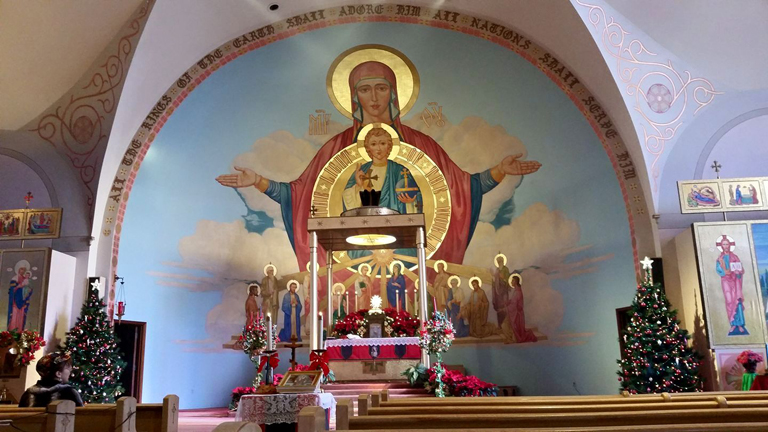
The church holds numerous spiritual services during the year. The Holy Rosary is said prior to each Mass on Sunday mornings at 11 a.m. and is a beloved devotion of the parishioners. Holy Spirit has a very active parish life and constantly sponsors flea markets, dinners, auctions and an annual food drive during Lent to help the less fortunate at a local food pantry. From very humble beginnings, this church has continued to thrive due and the parishioners look forward to the next hundred years when the Byzantine Catholic faith of this magnificent church will be passed to the next generation.
In Memory of Stephen and Mary (Stegena) Kovalscik
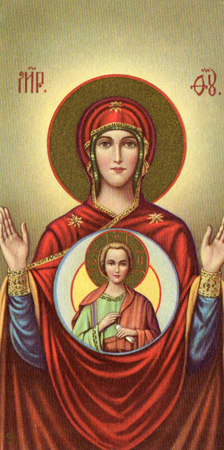
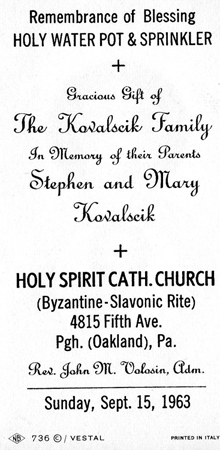
St. John the Baptist Byzantine Catholic Church
Pottstown, Chester County, Pennsylvania
TCC wishes to extend a special thank you to Father Nicholas de Prospero for offering the history and photos of his parish.
History
St. John's Church in 1903
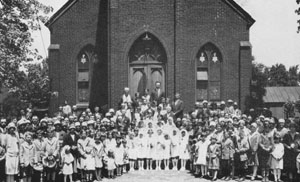 Immigrants from areas of the former Austro-Hungarian Empire began arriving in Pottstown in 1893. There were many opportunities for work at the mills which produced textiles, constructed boilers and constructed farm tools. Also, there were different foundries and many factories which produced shirts, bricks and fabrics. The area surrounding Pottstown was also known for its productive farming and dairying. By 1900 the population of Pottstown was 13,696, in 1910 it was 15,559 and by 1920 the population expanded to 17,431. Immigrants from the areas known today as Slovakia and Ukraine arrived in this town because of employment opportunities. Wishing to establish a Greek Catholic church to worship in the faith of their ancestors, the founders of St. John’s, John Artim, Michael Dezura, Michael Korinko, Andrew Parvenski, John Savko and Michael Suchoza, began the process of formerly taking steps for the construction of a church. In 1901 these original founders consulted with Father John Hrabar who was pastor of St. Michael’s Greek Catholic church in Mont Clare. Saint Michael’s was begun in 1896 and Father Hrabar was assigned as its first resident pastor. Father Hrabar was very knowledgeable with the requirements of beginning a new church; his experience was to prove invaluable to the members in Pottstown. The members in Pottstown wished to receive guidance and permission to begin a Greek Catholic Church and Father Hrabar agreed to assist them. To attend to their needs prior to the construction of a church, Father Hrabar traveled between Mont Clare and Pottstown to serve a Divine Liturgy and other sacraments for the Greek Catholics in Pottstown.
Immigrants from areas of the former Austro-Hungarian Empire began arriving in Pottstown in 1893. There were many opportunities for work at the mills which produced textiles, constructed boilers and constructed farm tools. Also, there were different foundries and many factories which produced shirts, bricks and fabrics. The area surrounding Pottstown was also known for its productive farming and dairying. By 1900 the population of Pottstown was 13,696, in 1910 it was 15,559 and by 1920 the population expanded to 17,431. Immigrants from the areas known today as Slovakia and Ukraine arrived in this town because of employment opportunities. Wishing to establish a Greek Catholic church to worship in the faith of their ancestors, the founders of St. John’s, John Artim, Michael Dezura, Michael Korinko, Andrew Parvenski, John Savko and Michael Suchoza, began the process of formerly taking steps for the construction of a church. In 1901 these original founders consulted with Father John Hrabar who was pastor of St. Michael’s Greek Catholic church in Mont Clare. Saint Michael’s was begun in 1896 and Father Hrabar was assigned as its first resident pastor. Father Hrabar was very knowledgeable with the requirements of beginning a new church; his experience was to prove invaluable to the members in Pottstown. The members in Pottstown wished to receive guidance and permission to begin a Greek Catholic Church and Father Hrabar agreed to assist them. To attend to their needs prior to the construction of a church, Father Hrabar traveled between Mont Clare and Pottstown to serve a Divine Liturgy and other sacraments for the Greek Catholics in Pottstown.
Once a plan was finalized, two lots were purchased at Vine and Walnuts Streets in Stowe. St. John’s was begun in 1903 and incorporated under the name “St. John the Baptist Church of Stowe, Pennsylvania.” However, most members resided in Pottstown and they revised the original plans to purchase new property in Pottstown. A groundbreaking ceremony was held on August 17, 1903 and the new church was begun. The Apostolic Visitator, Reverend Andrew Hodobay conducted the dedication service on November 22, 1903. The Apostolic Visitator was also the Titular Abbot and Canon of the Greek Catholic Diocese of Presov. He had been sent to America to survey conditions and the needs of Greek Catholic in the United States. He returned to Europe in 1906. His report resulted in the appointment of the Right Rev. Stephen Soter Ortinsky. Bishop Ortinsky was a Basilian monk and hegumenos of the Monastery of St. Paul in Michaclovka, Galicia. He was named as Bishop for Greek Catholics in America.
The inside of the new Church
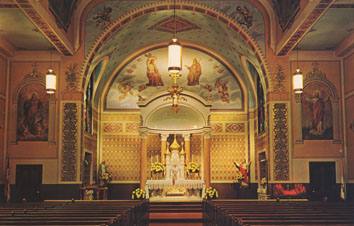 Once the church structure and interior plans were completed, the church was served by various visiting clergy, one being Father Michael Kuziv. In 1913, Bishop Ortinsky assigned a permanent pastor to St. John’s Greek Catholic church in Pottstown. During 1922, Father Zenon was appointed pastor and began an expansion program for the church. Having studied architecture, Father Zenon drew plans himself for the new church. Father Zenon previously had served during World War I and began to experience health problems. Unfortunately, he was forced to retire and later was buried in St. John’s church cemetery.
Once the church structure and interior plans were completed, the church was served by various visiting clergy, one being Father Michael Kuziv. In 1913, Bishop Ortinsky assigned a permanent pastor to St. John’s Greek Catholic church in Pottstown. During 1922, Father Zenon was appointed pastor and began an expansion program for the church. Having studied architecture, Father Zenon drew plans himself for the new church. Father Zenon previously had served during World War I and began to experience health problems. Unfortunately, he was forced to retire and later was buried in St. John’s church cemetery.
The construction program was not finished and in 1926, Father Peter Kustan was assigned to the church. St. John’s was expanding constantly due to the constant flow of immigrants from Europe. The church was finally completed and in 1929, Bishop Basil Takach performed the service of laying the cornerstone on May 30, 1929. It was during this period the old church was dismantled and a new pastor was assigned in 1930. The interior of the church was a beautiful house of worship. The imported marble was artistically placed and many murals were painted by famous artists of the day. The altar was a masterpiece of beauty. The tabernacle had three large gold cupolas and the marble altar had an inset of the last supper. Later, property was purchased for the construction of a new parochial school. After long years of hard work and dedication, the parishioners burned their mortgage in 1947. Bishop Daniel Ivancho presided at the celebration dinner. St. Johns parochial School was built and dedicated in 1958 and Bishop Nicholas T. Elko blessed the new school building. The children at the new school were taught by the Sisters of St. Basil from Uniontown, Pennsylvania.
An anniversary celebration was held in 1983 to mark the 80th year of St. John’s. Interior renovations were undertaken and a new Icon Screen and Baldachino were installed. Bishop Michael Dudick and Bishop Thomas J. Doinay participated at the services. In 1987, Father Nicholas de Prospero was installed as resident pastor. The parish grew and Father de Prospero’s hard work and devotion to St. John’s was appreciated by all the parishioners. St. John’s has a long history of vocations and in 1988 witnessed three ordinations to the priesthood. Deacons Edward Cimbala, Eugene Hutter and William O’Brien were ordained by Bishop Dudick, Bishop Dolinay and Bishop Kuzma. A banquet was held after the services and a newly ordinate deacon, Michael Erdek was assigned to St. John’s.
The Church today, as seen from the choir loft
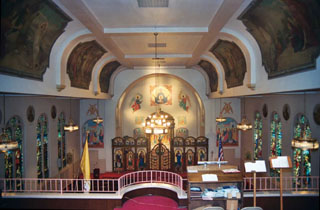
The continued growth of St. John’s continued and new teachers were added because of an increase in enrollment at the parochial school. In 2001 two assistant cantors were appointed to assist the permanent cantor, Mr. George Parvenski. St. John’s is a vibrant parish and holds numerous functions throughout the year. Some functions held are Vacation Bible School for children and young adults, an annual Slavic Food Festival, Adult Education Classes, St. John’s Guild Bus Trips and Sunday brunches. All these functions are very popular with parishioners and friends of St. John’s. For the past 108 years, St. John’s has been a thriving parish. Because of the hard work of its parishioners and clergy, St. John’s has seen a remarkable past and has a promising future.
St. John the Baptist Byzantine Catholic Church
Hawk Run, Clearfield County, Pennsylvania
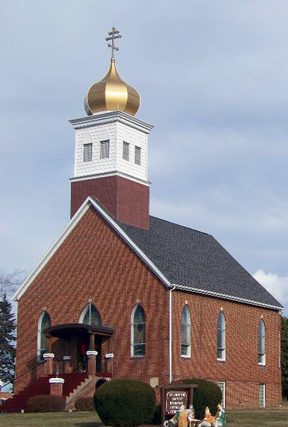
In the 1890's Ruthenian immigrants began to settle in the Philipsburg area of Clearfield County, Pennsylvania. Many of these new arrivals hailed from the former Austro-Hungarian Empire, from such counties as Spis, Saris and Zemplin. A group of these immigrants gathered to organize a church in their Greek Catholic Faith. Their first parish in Osceola Mills would within a few years of operation leave the faith of their ancestors and join with the Orthodox Church. Those that chose to remain Greek Catholic formed a new parish in Chester Hill. However, again after only a few years, this parish chose to affiliate with the Orthodox Church. Parishioners who were not happy with this choice decided to plan yet another Greek Catholic parish.
In 1903 this group of dedicated Greek Catholics purchased land in Hawk Run. By June 1904, the faithful collected $1798.74 and purchased two parcels of land for $150. A church was constructed of wood built on a stone foundation. This church building continues in use today.
The church was blessed and dedicated on the feast of St. John the Baptist, July 7, 1904. Approximately 2,000 were present, many of them having come from neighboring towns. A large tract of land was purchased for a cemetery with interments dating to 1906.
In 1920, a floor-to-ceiling icon screen was installed. The iconostas has been preserved in excellent condition over the years and adds to the beauty of this century-old church. In the 1930's a social hall was also constructed.
In later years, the church building was brick-sided and the original bell tower underwent major renovations. The old wooden dome and cross were removed and replaced with a bronze dome and new Byzantine cross. In recent times the church and dome were illuminated and can be seen within a five-mile range beyond Philipsburg.
In 1906 St. John the Baptist Church assisted in the establishment of a sister parish, the Dormition of the Mother of God Greek Catholic Church, in the nearby town of Clarence. In 2004 another sister parish was formed in the town of State College. St. John's parish and priest also assist in providing Byzantine Catholic services at Penn State University's main campus in State College.
St. John the Baptist Byzantine Catholic Church
Hazleton, Luzerne County, Pennsylvania
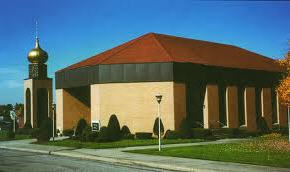 The City of Hazleton was incorporated on December 4, 1891. The population then was estimated at 14,000 people. In 1891, Hazleton became the third city in the United States to establish a city-wide electric grid. Due to the industrial nature of the city and with the factories, mills and coal mines, many laborers were required. Numerous immigrants came to Hazleton, including those who were Carpatho-Rusyn, in search of work. In 1889 approximately 40 families gathered to discuss building a Greek Catholic Church. Originally, the church was named Assumption of the Blessed Virgin Mary but due to internal problems, a new parish was organized under the title of Saint John the Baptist. The Most Reverend John Valyi, Bishop of Presov was contacted to send a priest to serve the church and care for the members spiritual needs. Property on Arthur Street was purchased and construction of the church initiated. In January, 1894, the church was dedicated with Fathers Cyril Gulovich of Freeland, Vladimir Molchany of Kingston and John Konstankevich of Shamokin officiating. In April, three bells were obtained and later two lots purchased for a cemetery from the Diamond Coal and Land Company. Father Cyril Gulovich and Father Vladimir Molchany blessed the bells and cemetery. Father Gulovich was the administrator of St. John the Baptist until a resident pastor could be appointed.
The City of Hazleton was incorporated on December 4, 1891. The population then was estimated at 14,000 people. In 1891, Hazleton became the third city in the United States to establish a city-wide electric grid. Due to the industrial nature of the city and with the factories, mills and coal mines, many laborers were required. Numerous immigrants came to Hazleton, including those who were Carpatho-Rusyn, in search of work. In 1889 approximately 40 families gathered to discuss building a Greek Catholic Church. Originally, the church was named Assumption of the Blessed Virgin Mary but due to internal problems, a new parish was organized under the title of Saint John the Baptist. The Most Reverend John Valyi, Bishop of Presov was contacted to send a priest to serve the church and care for the members spiritual needs. Property on Arthur Street was purchased and construction of the church initiated. In January, 1894, the church was dedicated with Fathers Cyril Gulovich of Freeland, Vladimir Molchany of Kingston and John Konstankevich of Shamokin officiating. In April, three bells were obtained and later two lots purchased for a cemetery from the Diamond Coal and Land Company. Father Cyril Gulovich and Father Vladimir Molchany blessed the bells and cemetery. Father Gulovich was the administrator of St. John the Baptist until a resident pastor could be appointed.
In 1894, Father Victor Martyak was appointed resident pastor of Saint John the Baptist. Like other members of the Ruthenian clergy, Father Martyak received his jurisdiction from the local Latin Rite Bishop, the Most Reverend Willliam O’Hara of Scranton. Sadly, on April 1, 1897, the entire church burned to the ground. The newly formed parishioners were devastated. After working hard and donating what little they could offer to build a Greek Catholic church, they would have to begin again. Not to be deterred, the parishioners set out immediately to rebuilt their beloved church. Herman Riebe of Landsford was hired as a contractor and within a year, a new St. John’s was built. The cost of the new church building was $4,500.00 and it was solemnly blessed on July 4, 1898. The interior altar, paintings and artistic decorations were executed by artist John Zacharias.
Father Martyak returned to Europe in 1900 and Father John Halyka was installed as the new pastor. Father Halyka purchased property and a rectory was built. Prior to this, the priest and his family were renting a home. The parish was incorporated on September 15, 1902 and father Halyka returned to Europe in 1907. Father Theodore Ladomirsky was appointed pastor but after four months was replaced in January of 1908 by Father Nicholas Martyak. Under Father Martyak’s guidance the church was enlarged due to the ever increasing numbers of parishioners. New stained glass windows were installed and other interior additions made. Bishop Ortynsky blessed the additions on September 7, 1908.
The church cemetery continued to expand and in 1909, 1915 and in 1930 more property was purchased. The cemetery cross was erected and blessed in 1916. A parochial school was begun in 1930 and on July 4, 1932 Bishop Basil Takach blessed the new school. On September 1, 1932, sisters from the Order of St. Basil the Great in Uniontown arrived as teachers. A new convent was constructed and finalized in April, 1933. On March 1, 1941 Father Valdimir Firczak was installed as Assistant pastor for Saint John’s. On February 1, 1954, the entire membership of St. John’s was heartbroken when they learned of the death of their pastor, Father Martyak. He had served St. John’s as a devoted and hard working priest for over 47 years. In March of 1954 Father Joseph Jackanich was installed as the new pastor. Father Jackanich began projects which were desperately needed. He oversaw renovations of the rectory, church and school and raised funds for a new church and rectory. After working tirelessly for many years, Father Jackanich was honored by being elevated to the rank of Monsignor.
During 1971 a new location was agreed upon which bordered on East 20th Street. Plans were drawn for a new church in April, 1973. A new church and rectory were constructed and blessed on July 7, 1974 by Bishop Michael J. Dudick. Monsignor Jackanich retired from the priesthood on June 17, 1981. He had served St. John’s for 27 years. In June, 1981, the Reverend Monsignor John Opalenick was installed as pastor. Monsignor Opalenick initiated many needed repairs and renovations to the church, parochial school and cemetery. Saint John the Baptist parochial school celebrated its 50th anniversary on May 29, 1983. The school library was dedicated to the memory of the late Father Nicholas Martyak who was the founder of the parochial school.
Monsignor Opalenick’s pastorate was very active and many spiritual activities were conducted. A special year of prayer for vocations was held at the church and during the Marian Year; the Icon of Our Lady of perpetual Help from Uniontown was taken to each parish in the deanery. Later, the cemetery was updated and a program initiated to offer perpetual care. Renovations of the church also took place at this time and a new altar was installed.
Saint John’s has been blessed with numerous vocations to the priesthood and religious life. Some of these vocations are Fathers Michael Korba, John Krushko, Michael Rapach, Paul Firczak, Basil Schott (later to become Metropolitan Archbishop of the Archeparchy of Pittsburgh) and some of those names who entered religious life are Sister M. Victoria (Ann Puhak), Sister M. Nathaniel (Catherine Prosko), Sister M. Annunciata (Helen Schott). Saint John’s has always been a spiritual and vibrant parish and this is truly seen in the number of priestly and religious life vocations from the church.
From inception till 1974 the following served faithfully either as cantors or as cantors an choir directors: Myron Petrashovich, Alex Ladomersky, Theodore Porchapski, Stephen Chanda, J. Leshko, Basil Margitich, Julius Dobra, John M. Mitchell, Andrew Parvensky, Peter Roman, Andrew Morros, Gabriel Flintosh and Stephen Shutovich.
As of 1974 the total number of Baptisms adminstered were 6, 198; Marriages 1, 732; Burials 2, 181.
The 100th Anniversary of Saint John’s took place on October 17, 1993. Bishop Dudick offered a Pontifical Divine Liturgy. Also, in honor of the church ancestors and founders, ninety-eight members, past and present, appeared to sing a majestic Divine Liturgy in Church Slavonic under the director of Cantor Professor Emil Simojdejka. Saint John the Baptist Greek (Byzantine) Catholic has a long history and has been abundantly blessed by God during this time. The church is still a thriving parish with weekly Pirohi making sessions and aluminum can drive which assists to benefit the cemetery fund. St. John’s is currently served by Father Carmen Scuderi, OFM and Deacon Lawrence Foran. St. John’s continues to serve the Greek (Byzantine) Catholic faithful. A beautiful house of worship, for over 118 years the church has seen a rich history and has a promising future.
Saint John’s Byzantine Catholic Church
Lansford, Carbon County, Pennsylvania

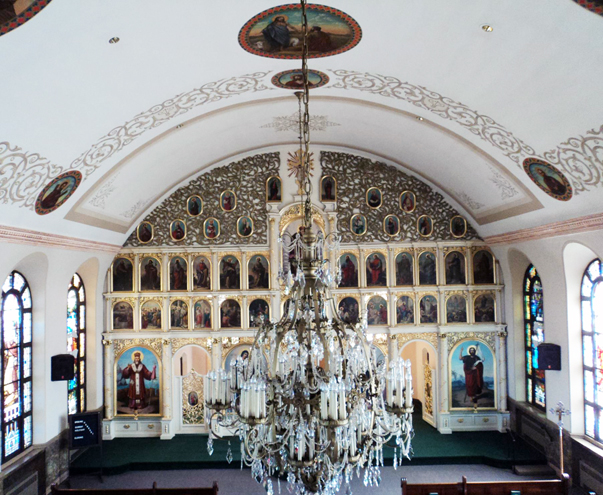
Greek Catholic Immigrants from the Austro-Hungarian Empire in Lansford, Pennsylvania began discussions of building a church. On September 22, 1891 a meeting was held and plans finalized. To pay for the new church, dues of seventy-five cents were assessed. These payments were deducted automatically from those who worked at the LC&N Coal Mining Company. It is notable that a miner at that time period made approximately one dollar a day. This was a considerable financial sacrifice but the miners gave it gladly to ensure they would have a church. The cornerstone for the first church was installed on May 8, 1892. The church held a mission parish status until 1895. Father Gabriel Martyak was assigned as pastor to guide this new parish. He served this parish from 1895 until 1898. Later, the membership had grown so large a new church was necessary. This church, all constructed by parishioners, was finished and blessed on November 26, 1907. It is a testament to the faith of these beginning members that the second church was built with a seating capacity of 1,000 people. Their happiness turned to sorrow four months later when tragedy struck, a terrible fire broke out and the church burned down.
The parishioners were heartbroken but not defeated. They once again constructed another church quickly. Father Martyak was again assigned to Saint John’s constructed a third church which was blessed and dedicated on April 15, 1911. The church is located on East Bertsch Street and was constructed of brick. No expense was spared to make this a glorious house of worship for the faithful. The exterior is magnificent with three soaring towers capped by golden domes. The church interior was decorating with beautiful murals, a large chandelier was imported from Europe to hang from the center ceiling and three bells were purchased for the bell towers which were christened with the names Demetrius, Ivan and Michael.
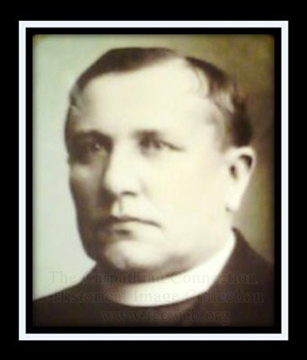
Father (now Monsignor) Gabriel Martyak would labor unceasingly to serve his parishioners and the Greek Catholic faith at this parish. He was also appointed the Apostolic Administrator of the Ruthenian Greek Catholic Church in the United States. He now not only served Saint John’s but, served the entire church as Administrator which he would do so faithfully until 1924. Under Monsignor Martyak’s guidance, the church grew rapidly and many improvements and expansions were added. In 1920, land was purchased for a cemetery as a final resting place for Greek Catholics. A small chapel was constructed with bricks and stones that were the remains of the second church fire. These bricks were treasures to the parishioners. They struggled very hard to pay all costs and work to ensure that they had a church which was the faith of their ancestors. The men of the church constructed the chapel by hand and walked back and forth hauling the bricks from one location to another.
On April 16, 1934 sadness once again visited Saint John’s. Their beloved priest, Monsignor Martyak passed away. His funeral was held at Saint John’s and the church was so filled others had to stand on the sidewalk outside the church. He was laid to rest at the cemetery chapel and is interred under the chapel altar. Father Michael Morris was assigned to Saint Johns in June, 1934. Father Michael was a very hard working priest and looked after the spiritual needs of his parishioners with great care. He established a Ladies Guild, men’s Holy Name Society, Rosary Society, Ladies Sodality and a pierogi committee to ensure income for the parish. A tireless worker, Father Michael was dedicated to Saint John’s and served faithfully until 1969. Father Emil Sopoliga was assigned as pastor for Saint John’s and he undertook many much needed renovations to the interior and exterior of the church. Also, he began a formal religious education program for so the children of the parish would have weekly religious lessons.
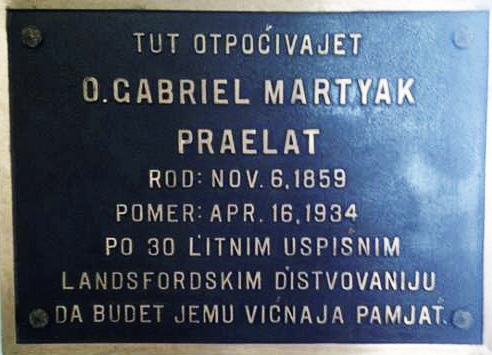
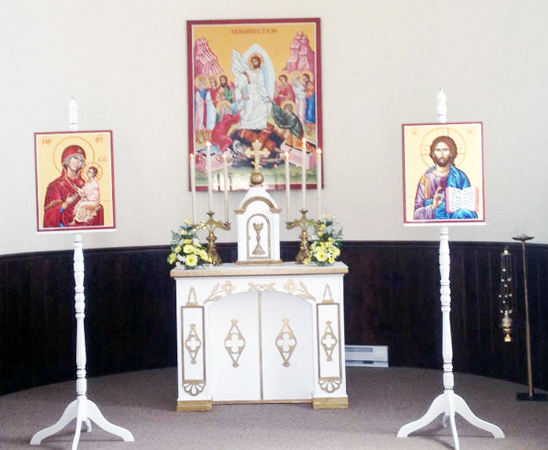
During the 1980’s and 1990’s other modernizations were implanted for the parish and cemetery. Today, Saint John’s is a vibrant and welcoming church. Two Liturgies are held at 4 p.m. on Saturday and 8:30 a.m. to accommodate the parishioners. The church social hall continues to be a very popular rental for various events and many functions are held throughout the year. From humble beginnings in 1891, Saint John’s has served the Byzantine Catholic faithful of the Lansford region for approximately 125 years. The church welcomes all to worship with them and see the beauty and appreciation of the Byzantine Catholic faith.
A Greek Catholic Rosary Miracle?
Many places are famous for documented miracles. Most have heard of Lourdes, Fatima and Medjugorje. However in the summer of 1928 a story took hold that spread throughout the United States. It happened in Landsford, Pennsylvania. Newspaper accounts reported a Rosary Miracle in Landsford. Some believe this account but others discount it. However, for those who believe, no explanation is necessary, for those who do not believe, no explanation is possible. This story was reported as far away as the Arkansas Catholic Newspaper. As recently as two years ago the Times News of Pennsylvania published an article about this event. The “Miracle of the Rosary” all began on July 12, 1928 but, the events leading up to that date are very important.
Michael Kusko was a Greek (today called Byzantine) Catholic young man who was a parishioner of Saint John’s Byzantine Catholic Church in Landsford. He was reported to be a very religious person, possibly even a potential vocation such was his faith. Like many immigrants, he was employed in the coal mines in the Lansford region. Day after day, he toiled under harsh conditions for meager wages. His church, begun in 1892, was a beautiful house of worship. It was at this church that Michael attended services. During 1923 a terrible accident injured Michael at the Number 8 Colliery Mine. This coal car accident left Michael with a broken back. At a time when there was limited medical care and no form of income continuation for the disabled, Michael at first must have worried what would happen to his family. He suffered greatly for five long years and on numerous occasions it appeared that he would surely die. Reserved to his fate, he turned to prayer for strength. As he was totally disabled, he was placed in Coaldale Miners State Hospital (today called Saint Luke’s Miners Memorial Hospital). Staff and patients who were interviewed later told of even in the midst of his terrible suffering, he was very kind to everyone and always prayed.
Eventually, his suffering was ended and Michael passed away. He was brought to his home at 346 West Bertsch Street as was the practice years ago for a wake. He was placed in a coffin and laid out for viewing. Mrs. Kusko, who was a devout Greek Catholic, placed a simple rosary in his hands. It was reported she received this rosary from a missionary priest who obtained it in Rome. It was also alleged that Pope Pius XI had blessed it. Mrs. Kusko had prayed on this rosary fervently for the recovery of her son all during his illness.
Grief stricken, Mrs. Kusko prayed at the coffin of her son with this rosary in his hands. At this point, something undefinable began to take place. The room was crowded with mourners and Michael’s brother Andrew noticed something odd. As he drew closer it appeared that the beads on the rosary were opening like flower petals. At first, Andrew thought he was seeing things. But upon looking closer, this is exactly what was happening. He told others in the room to look and they were astonished. Slowly, silently, flowers were opening on beads of the rosary. This continued to take place and people were amazed. Eventually, 24 of the beads had opened into lily flowers. Word of this miracle spread like wild fire throughout Landsford and beyond. People who did not know Michael or his family suddenly began travelling to see this amazing scene for themselves. Mrs. Kusko did not know what to do, people continued to come to her home. Cries of “a miracle” were heard throughout Landsford. The news media picked up the story and it was reported far and wide.
The crowds were becoming so dense in Lansford law enforcement officers had a hard time keeping order. Newspapers in Pittsburgh ran a story that lilies appeared on a dead man’s rosary. On July 15, 1928 the Pittsburgh Press reported “Traffic officers were pressed into service today to cope with the crowds.” No one could explain this situation. The more people that viewed this, the more they reported this story to others. Residents of the town talked of nothing else and all tried to give an explanation. Why was this happening? Is the Virgin Mary telling us something? What did this mean? Finally, Michael Kusko was taken to Saint John’s Greek Catholic Church for his funeral Mass. He was interred at Saint John’s Greek Catholic Cemetery in Summit Hill. However, prior to burial the parish priest, Monsignor Gabriel Martyak requested that the family give him the rosary. Monsignor Martyak placed the rosary in a safe location with other church liturgical items. After the excitement of this event, Monsignor Martyak asked the Kusko family for permission to send the rosary to church authorities. The rosary, with the beads of lilies, was sent to the Greek Catholic Diocese of Pittsburgh for an investigation.
Today, it is unknown if Church authorities gave Monsignor Gabriel Martyak or the Kusko family an answer. Mrs. Kusko’s granddaughter was asked by reporters if there was any resolution to this event but she did not know of any. The story of the miracle of the rosary did not end here though. Individuals and members of the clergy continued to write to various people asking what had happened. On November 17, 1928 Father Christopher Fitzmaurice, O.F.M. of Alexandria, Egypt wrote to Notre Dame University. He inquired that he would like to have more information regarding this potential miracle. Whether or not clergy or other Catholic related intuitions contacted the Greek Catholic Diocese of Pittsburgh and received a response is unknown. However, it appears inquiries were made. With the passing of so many years and those who witnessed this, the full story of the miracle of the Rosary in Lansford, Pennsylvania remains a mystery. However, consider this, the lily is a symbol of rebirth. Lilly plants are the flowers most associated with Easter. Possibly, this sign was to honor Michael Kusko’s suffering, steadfast faith and that he never gave up in the face of personal trial.
Saint Mary-Dormition of the Mother of God Byzantine Catholic Church
Freeland, Luzerne County, Pennsylvania
The oldest church in the Pittsburgh Byzantine Metropolia The First Byzantine-Ruthenian Church in the United States
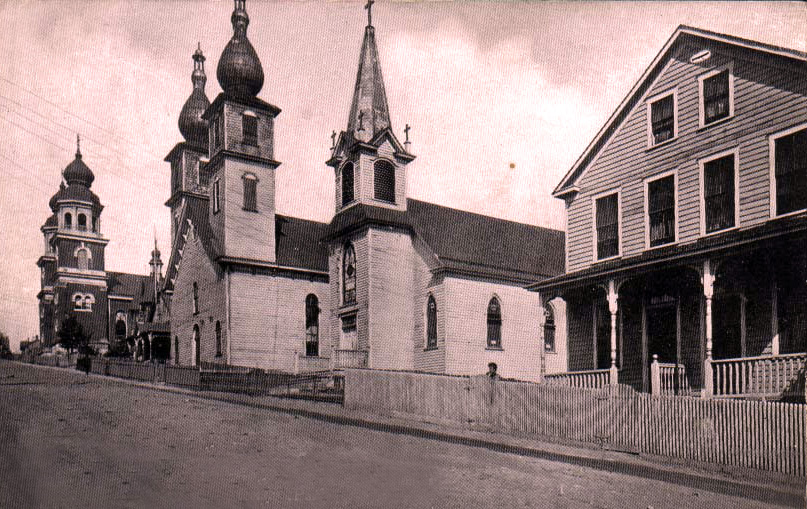
St. Mary's (new) church 1907 is on top of the hill. The (old) church 1888 is in the center of the three churhes.
Waves of immigrants came to the United States in the middle to late 1800’s seeking a better life. It was during this time thousands of people from the Carpathian Mountain regions left their homes and came seeking employment. During 1885, many Carpatho-Rusins/Ruthenians began to arrive in Freeland, Pennsylvania. Since coal mining was the major industry in this borough, the need for laborers was a necessity. The town had many other churches for those from Eastern Europe. The first Slovak Lutheran church in America was begun in Freeland during 1883. A church which would become the oldest church in the Pittsburgh Byzantine Catholic Metropolia, St. Mary’s, was started here. In 1884, the members desperately wanted a Greek Catholic church. They sent a petition to Archbishop Sylvester Sembratovitch, Metropolitan of Lemberg (today called Lviv) stating if a priest were sent, a church would be constructed. Father Ivan (John) Volansky of the Diocese of Lemberg arrived in the United States in late 1885. Father John was the first Greek Catholic priest to arrive in the United States. For one year he celebrated the Divine Liturgy and other services in a rented hall. Finally, after much planning and hard work, St. Mary’s was formally incorporated in 1886.
The membership arranged for construction of a church in March of 1887. Work progressed quickly and the new church was fully completed during 1888. The church was blessed and dedicated to the Virgin Mother of God under the title of her Dormition. The church grew rapidly and before long it was apparent a new structure would be required. During 1907, a new church was constructed. The old church was relocated further down the street for the new church to be constructed on the original site. The corner stone was placed with solemn ceremonies on Memorial Day of that year. Bishop Hoban participated along with the pastor of St. Marys. The architect of the new church, Architect Owen McGlynn of Wilkes-Barre, was also invited to witness the dedication of the church he drew plans for. At this point, the roof still was in the process of construction which, was completed a short time later.
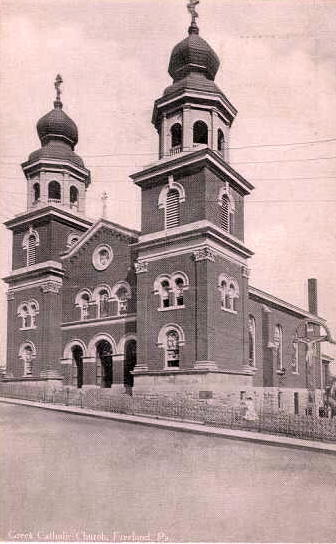 After completion of the construction and relocation of the churches, the members turned their attention to the children of St. Marys. The church felt it was important that their children receive a good education. Plans were made over time to construct a parochial school which would have a eight grades and also include classes for the students in their Greek Catholic faith.
After completion of the construction and relocation of the churches, the members turned their attention to the children of St. Marys. The church felt it was important that their children receive a good education. Plans were made over time to construct a parochial school which would have a eight grades and also include classes for the students in their Greek Catholic faith.
During 1925 the exterior of the church building was stuccoed and a dedication service was held for the parochial school. The school building was finally completed during 1926. To teach the Greek Catholic religion, the school invited the Sisters of the Order of St. Basil the Great in Uniontown to serve as catechists. Later, during 1945, five sisters were permanently installed to teach eight grades. The school was in operation for many years but, in 1979 had to be disbanded due to high operational costs. The entire building was taken down in 1984 and a new building, St. Mary’s Parish Center, was constructed. Father Leonard Hoffick was pastor during this period and he installed a new icon screen and oversaw numerous renovations within the church.
Major preparations were made in anticipation of the 100th anniversary of St. Marys. The members and their pastor worked hard to organize a large celebration for this important day. On August 17, 1986 numerous clergy and dignitaries filled St. Marys, the first Byzantine-Ruthenian parish in the United States. In attendance were Metropolitan Archbishop Stephen Kocisko, Bishop Michael Dudick, Bishop Andrew Pataki, Bishop Thomas Dolinay, Bishop John Biock and Bishop James Timlin of the Roman Catholic Diocese of Scranton.
St. Mary's has numerous organizations within the church. Some of the organizations are: the Altar & Rosary Society (the oldest organization within the parish), St. Nicholas Apostolate, St. Mary's Byzantine Catholic Youth Organization, St. Mary’s Choir and St. Mary's Athletic Association. These various organizations and societies benefit not only the members but, those in the community with their events and various functions. St. Marys has no lack of those willing to work hard for their church. St. Mary’s Pirohi Workers and Caterers have continued for years with fund raising events that benefit the church. The funds raised by the workers and caterers are of great financial assistance to the parish. Also, the church has provided a weekly broadcast on local radio of the Sunday Divine Liturgy. During Christmas and at other times of the year, special programs are also offered for those who cannot come to church. For over 125 years, St. Mary’s has been a vital presence in Freeland, Pennsylvania. The church and her members look forward to the next 125 years of service to the Byzantine Catholic church and to their local community.
St. Mary's Byzantine Catholic Church
Kingston, Pennsylvania
TCC wishes to extend a special thank you to Mr. Paul Gresh & the church council for offering the history and photos of the parish. In 2012 they will be celebrating the 125th Anniversary their church.
History & Photos
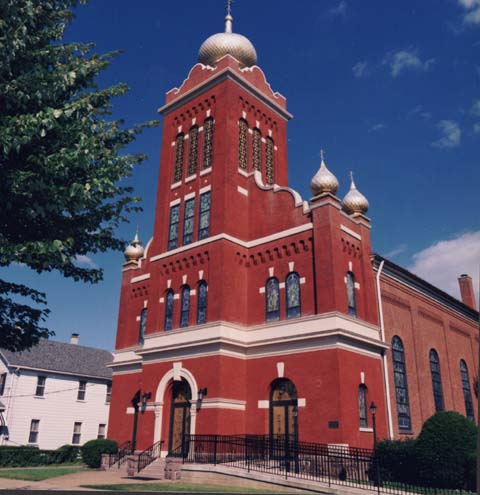 The history of St. Mary's Byzantine Catholic Church traces its beginning to the year 1887, when a group of dedicated Eastern Europeans gathered to make plans to erect a church in which they could worship according to their Eastern Catholic traditions.
The history of St. Mary's Byzantine Catholic Church traces its beginning to the year 1887, when a group of dedicated Eastern Europeans gathered to make plans to erect a church in which they could worship according to their Eastern Catholic traditions.
These Sub-Carpathian Ruthenians, or Carpatho-Rusyns, came from the northeastern part of the then Austro-Hungarian Empire (present day Slovakia and Ukraine) and held a great devotion to their Byzantine (Greek) Catholic Church. Other Slavic groups, that is Slovak and Polish, who had earlier immigrated into this region possessed similar ethnic customs, however, they were quite different in their religious (Roman Catholic) rites. It was this difference in religious ritual, along with a fervent desire to worship in their own tradition that led to the formation of St. Mary's Church.
St. Mary's, of Kingston, PA., is a member of the Eparchy of Passaic under the direction of His Grace The Most Reverend William C. Skurla, DD Eparch of Passaic. It is one of the oldest Byzantine parishes in the United States, having been started in 1887 under the leadership of Rev. Father Ivan Volansky the first Ruthenian priest to arrive in America. In 1892 an application for a charter was presented to the local Luzerne County Court. On May 16, 1892 the articles of incorporation were granted to the parish under the title of Saint Mary's Patronage (Pokrov) Greek Catholic Church of the Borough of Kingston, Pa.
St. Mary's Church in Kingston is the mother church for four other Eastern parishes in the area: Sts. Peter and Paul Ukrainian Catholic Church, Plymouth, Pa.(f.1898); St. Nicholas Byzantine Catholic Church, Swoyersville, Pa.(f.1904); St. Vladimir Ukrainian Catholic Church, Edwardsville, Pa.(f.1910); and St John's Russian Orthodox Church, Edwardsville, Pa.(f.1910). St. Mary's Byzantine Church, of Wilkes-Barre, Pa., was founded and built soon after St. Mary's Byzantine Catholic Church in Kingston was established. Until their church was completed the Wilkes-Barre faithful attended the Kingston church.
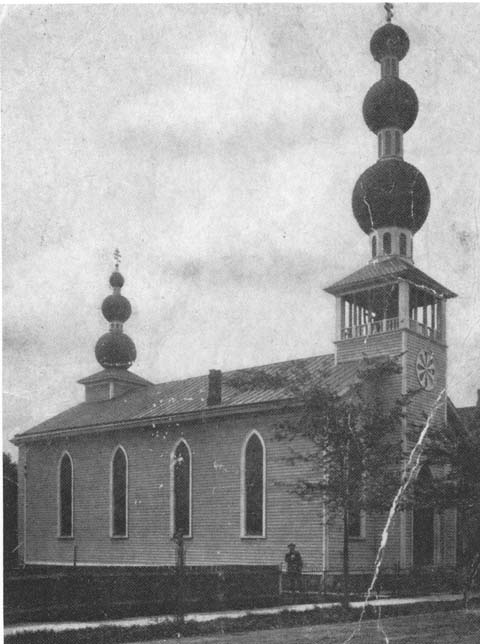 The original wood frame structure, which was later brick veneered and now serves as the parish hall, served as the parish church until 1911. In May of 1911, about one hundred St. Mary's parishioners met to formulate plans for the construction of a new church. The new, red, brick church, whose cornerstone was blessed on July 4, 1911, was built for the sum of $32,933.00.
The original wood frame structure, which was later brick veneered and now serves as the parish hall, served as the parish church until 1911. In May of 1911, about one hundred St. Mary's parishioners met to formulate plans for the construction of a new church. The new, red, brick church, whose cornerstone was blessed on July 4, 1911, was built for the sum of $32,933.00.
Two new church bells were purchased from McShane Bell & Foundry Co., Baltimore, Md. for the sum of $1,450.00. The largest bell, named Paul, and the smallest bell, named Peter now joined a medium sized bell named Mary, which was moved from the original church and to this day they continue to call the faithful to worship at their beautiful church.
The parish celebrated the One Hundredth Anniversary of its founding in 1987. In addition to the considerable work done to prepare the church for this celebration, a chapel was constructed in the parish cemetery in Edwardsville, Pa. The chapel was blessed and additional cemetery land consecrated on November 7, 1988 by The Most Reverend Michael J. Dudick,DD, who was then the Bishop of the Eparchy of Passaic.
Over the years, the dedication of the many pastors, cantors and church council members, along with the generosity of the parishioners has resulted in many restorations and new constructions to maintain the beauty and structural integrity of the church and parish grounds. However, none was more significant than the effort made to restore the church after the devastation caused by the Hurricane Agnes Flood of 1972.
A brief history such as this does not allow sufficient space to name all of the individuals who have made significant contributions to our church. However, their efforts are nonetheless greatly appreciated and quite evident in maintaining St. Mary's Byzantine Catholic Church, in Kingston, Pa. as a beautiful house of worship.
Saint Mary Holy Protection Byzantine Catholic Church
Latrobe, Westmoreland County, Pennsylvania
65th Anniversary Book Cover
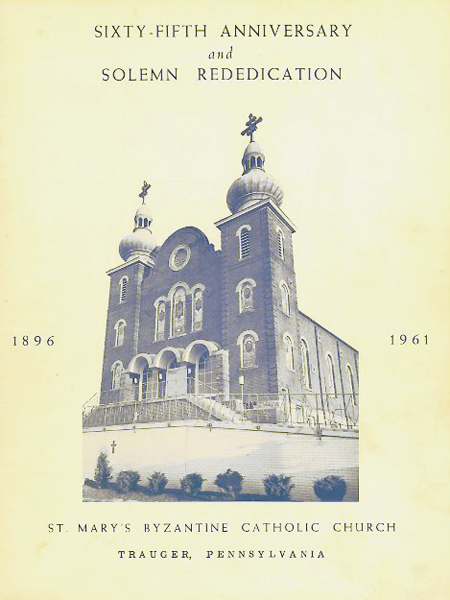
During the turn of the century numerous immigrants arrived in Pennsylvania from the former Austro-Hungarian Empire (present day Slovakia, Southern Poland and Western Ukraine) seeking employment. Many came to Pennsylvania to work but also, they wanted to worship God in their ancestral faith. These Carpatho-Rusyn immigrants were dedicated to the Greek Catholic Church and their first concern was to construct a parish. On January 1, 1894 Saint Mary’s Greek Catholic Church was begun under the direction of Father Stephen Dzubay. At first, they worshiped in a rented hall in Calumet, Pennsylvania. Father Valentine Balog (who would later serve at Saint Michael’s Cathedral in Passaic, New Jersey) served the needs of the parishioners during these early days. The church was officially incorporated on April 8, 1896 and on May 4, 1896 land was purchased in Trauger, Pennsylvania. Within a very short time the wooden church and a social hall were finished. This social hall was very important. It was here the priest and cantor taught religious instruction and traditional music (Prostopenij Chant) of the Greek Catholic Church to the children of the parish. During the 1900’s the parish expanded so much they were able to offer a full time school for instruction. Land above the church was also acquired and this was reserved for a cemetery.
As more immigrants arrived, Saint Mary’s grew at a fast face. Seeing the original church was too small, plans were made to construct a larger church. During October of 1912 more land was purchased and the current church was begun. The corner stone was blessed on August 16, 1914 and the church was completed to the overwhelming happiness of the parishioners and their priest, Father Michael Lukats. This happiness later led to concern as during the 1920’s it was visible the church was sinking. The cause of this sinking was coal was being removed from under the church. The firm that caused this, H.C. Frick Company, resolved the matter by making all repairs and ensuring the church was stable.
On September 9, 1928, the Most Reverend Bishop Basil Takach along with St. Mary’s pastor Father Gabriel Chopey, blessed the church after all repairs were finalized. During the years 1930 to 1934 Father Volkay was Saint Mary’s pastor. In 1934, Father Demetrius Yackanich was assigned to St. Mary’s. These were difficult years as the depression was at its height and many had no employment. Father Demetrius and his parishioners worked diligently to pay the debts incurred for the construction of the church. In 1944, the Franciscan Fathers of the Latin Rite served as bi-ritual priests. Father Matinian Krajeir and Father Francis Duchala served Saint Mary’s from 1944 to 1959. At this time Saint Mary’s saw its first vocation to the priesthood and on June 2, 1957, Father Andrew Kofile celebrated his first Divine Liturgy at his home parish. On May 6, 1969 Bishop Nicholas T. Elko assigned Father Lawrence Slavik to Saint Mary’s. Father Slavik had a number of projects to complete as the steps to the church were deteriorating and other upgrades were necessary. As a consequence of this, it was decided to renovate the exterior of the church, install new steps and reinforce the foundation which was accomplished in 1960.
In 1962 the property across from the church was dedicated for use as an educational and recreational hall. Saint Mary’s Center was completed in 1963 and is utilized to the present day for numerous functions. During the years of 1965 to 1988, the church was served by *Father Andrew D. Bachkovsky. Father Andrew was a talented and much beloved pastor. During his tenure a new granite cross was installed at the cemetery, the interior was re-painted and the mortgage on the center was paid in full. Father Andrew also instituted the annual Christmas Dinner which is always held closest to the Feast Day of Saint Nicholas. This dinner was a very popular event for both the parishioners and children of the parish. Also, during this period two more parishioners entered religious life. Sister Elizabeth Jane Tepley entered the Sisters of Saint Basil in Uniontown on August 15, 1970 and Father Regis John Dusecina was ordained to the priesthood on May 20, 1973. In 1988 Father Frank Firko was assigned to St. Mary’s as Father Andrew was ill. During 1988, the parishioners of Saint Mary’s were very sad to learn Father Andrew passed away. He had served Saint Mary’s faithfully for over thirteen years, his loss was felt very deeply and his funeral was held at Saint Mary’s.
Father Edward Pyo was sent as pastor for St Mary’s and once again, along with the dedicated parishioners, more improvements were made and another new roof installed. Also, at this time the annual church festival was re-started and has continued to the present time. The interior of the church is welcoming. There is a lovely statue of Our Lady of Fatima which has a stained glass window behind it. The soft glow of light behind the Blessed Mother’s statue is very comforting. The altar is stunning with icons that surround the main altar and compliment the altar table gracefully. Above this there is a circular light blue stained glass window with a chalice. Above the stained glass window is an icon of Our Lady of the Sign. The exterior grounds are meticulously maintained. There is an outdoor shrine with a lovely statue of the Blessed Virgin Mary with the Child Jesus on a red brick pedestal. Saint Mary’s is a vibrant Byzantine Catholic church with a very diverse membership. The parishioners are very active in the life of the parish which celebrated its 100th anniversary in 1994. Critical to the life of any church, Saint Mary’s has a well-attended BCY and Youth program. Today, as in the past, the youth of the parish are being taught their Byzantine Catholic faith so they can carry this forward for future generations.
*Father Andrew D. Bachkovsky was the son of Joseph Bachkovsky from the village of Stefurov, Slovakia and Mary Osifchin from the Carpatho-Rusyn village of Maly Lipnik, Slovakia.
St. Mary's Holy Protection Byzantine Catholic Church
Homer City, Indiana County, Pennsylvania
TCC wishes to extend a special thank you to Fr. Cuthbert Jack,O.S.B. for offering the history and photos of his parish.
A Short History of Holy Protection Church
Our parish has its beginnings in 1918 under the guidance of Fr. Constantine Auroroff when a parcel of land was bought on Yellow Creek Street in Homer City for $3,500. The Very Rev. Gabriel Martyak was chosen to be the first administrator and the parish was dedicated to the Mother of God under the title of Her “Holy Protection” or “Pokrov” in Slavonic. This is the actual dedication of most Byzantine Catholic parishes known as “St. Mary.”
The original parishioners numbered some 50 families most of whose fathers were immigrant coal miners. From the very beginning, there has been an ethnic mix of those who identified themselves as “Ukrainians” and others who were called “Euro-Rusyns (the latter having their origins in the Carpathian mountains of what was then the Austro-Hungarian Empire). Ordinarily, these two groups would have formed separate churches but it seems to have been agreed from the beginning to put aside differences and establish a single “Greek-Catholic Church” to serve the needs of both peoples.
The first church building was constructed in 1919 at a cost of $12,775 and in 1920 Fr. Andrew Koman became the first resident pastor and a house was purchased for use as a rectory.
After a several more interim pastors, Fr. John Bajcura was appointed and remained for the next 38 years. It was during his pastorate that Bishop Basil Takach was forced by the Vatican to introduce mandatory celibacy into Byzantine Catholicism in America. This was very controversial and many supporters of the older system of clerical marriage expressed their opposition. As a married man with a wife and children, Fr. Bajcura protested by means of a hunger strike in front of the Apostolic Delegate’s office in Washington but to no avail. Fr. Bajcura reluctantly accepted the decision and returned to his parish and served well for the next 35 years.
With the increasing use of the Gregorian calendar, a bitter parish dispute broke out in the early 1940s resulting in the loss of 35 families and the formation of a new parish dedicated to SS Peter and Paul under the direction of the Johnstown Diocese of the Russian Orthodox Greek Catholic Church.
In 1945 a mission church, dedicated to the Holy Cross, was established in nearby Coal Run to meet the needs of the people in that town. Fr. Bajcura, despite poor health, was able to organize a second mission parish dedicated to St. Jude in Ernest in 1949. A year later in 1950, English was introduced into the liturgy a full 13 years before the start of Vatican II. In 1965 a new rectory was completed but Fr. Bajcura would only live in it 6 months longer before being forced to retire due to poor health. He died in 1967.
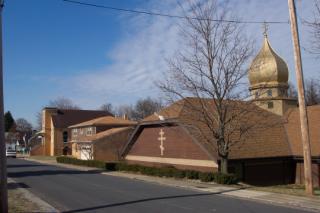 Father Bajcura was succeeded by a series of short term pastors and in 1969 the parish celebrated its 50 year anniversary with a burning of the mortgage for the new rectory and a renovation of the church with the installation of a new icon screen in line with the directives of Vatican II for the Eastern Churches. By 1985 the parish was out growing the church and a steering committee was established to explore the possibility for a new building. With the coming of Fr. Nicholas Ferencz in 1986, things came to fruition and construction began in 1988.
Father Bajcura was succeeded by a series of short term pastors and in 1969 the parish celebrated its 50 year anniversary with a burning of the mortgage for the new rectory and a renovation of the church with the installation of a new icon screen in line with the directives of Vatican II for the Eastern Churches. By 1985 the parish was out growing the church and a steering committee was established to explore the possibility for a new building. With the coming of Fr. Nicholas Ferencz in 1986, things came to fruition and construction began in 1988.
The new church is in keeping with the ancient Byzantine tradition. It is oriented toward the East which is the traditional direction of prayer for all Christians. (The original meaning of the word “oriented” means to be “facing east”). The nave is surmounted with a classic “onion” dome representing the vault of Heaven made by Tech-Fab Inc. of Kentucky. Atelier of Eugene, Oregon designed and built the icon screen. The icons themselves are the work of iconographer, Nicholas Papas of Greensburg.
Looking up we see Christ the Pantocrator “Ruler of all.” And in the apse above the altar we see Mary the Theotokos “God-bearer” representing the Incarnation of Jesus Christ, Her Hands stretched out in intercession.
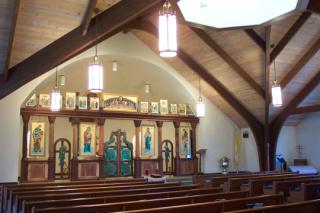 The icon screen itself contains Christ and the Theotokos in their usual positions on either side of the great doors along with icons of St. Nicholas and St. John the Forerunner to the north and south of the deacon’s doors. March 25 the Feast of the Annunciation was in 1989 also Great Saturday and the first occasion for the Divine Liturgy to be celebrated in the new church.
The icon screen itself contains Christ and the Theotokos in their usual positions on either side of the great doors along with icons of St. Nicholas and St. John the Forerunner to the north and south of the deacon’s doors. March 25 the Feast of the Annunciation was in 1989 also Great Saturday and the first occasion for the Divine Liturgy to be celebrated in the new church.
In the year 2002, the mortgage on the new church was paid off by the combined efforts of the whole parish. The people of Holy Protection are today a multi-ethnic family of friendly and hardworking people always ready to greet visitors and to welcome new members.
Parish Pastors
Rev. Constantine Auroroff 1918 - 1919
Very Rev. Gabriel Martyak 1918
Fr. Andrew Koman 1920 - 1922
Fr. John Soroka 1922 - 1925
Fr. Eugen Volkay 1925 - 1927
Fr. John Bajcura 1927 - 1965
Fr. Peter Zeman 1965 - 1967
Fr. Thomas Maskornick 1967 - 1973
Fr. Regis Dusecina 1973 - 1977
Fr. Thomas Saiko 1977 - 1980
Fr. John Joseph Koza 1980 - 1985
Fr. Donald Valasek 1985 - 1986
Fr. Nicholas Ferencz 1986 - 1991
Fr. John Cuccaro 1991 - 2000
Fr. Edward Pyo 2000 - 2002
Fr. Cuthbert Jack 2002
Saint Michael the Archangel Byzantine Catholic Church
Allentown, Lehigh County, Pennsylvania
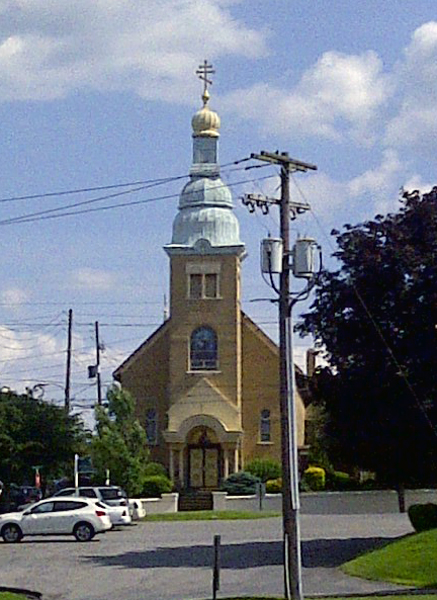 In 1900, large numbers of Greek Catholics emigrated from the Carpatho-Rusyn populated counties of the former Austro-Hungarian Empire to the United States, Canada, and South America. Some found their new home in the Allentown area of the Lehigh Valley of Eastern Pennsylvania. At first these new immigrants worshiped with their fellow Greek Catholics at St. John’s in Northampton, Pennsylvania.
In 1900, large numbers of Greek Catholics emigrated from the Carpatho-Rusyn populated counties of the former Austro-Hungarian Empire to the United States, Canada, and South America. Some found their new home in the Allentown area of the Lehigh Valley of Eastern Pennsylvania. At first these new immigrants worshiped with their fellow Greek Catholics at St. John’s in Northampton, Pennsylvania.
On April 13, 1907 an official meeting of members of Greek Catholic Union Lodge 418 was held at Sacred Heart German (Latin) Catholic Church to organize a Greek Catholic Church in Allentown. It was to be named and placed under the protection of St. Michael the Archangel. On July 5, 1907 through the sacrifice and dedication of these early parishioners the property at 152-162 Green Street was purchased from the Allentown Iron Company. Construction of the new church began in September of that year. The State of Pennsylvania granted a charter to St. Michael’s on June 6, 1908.
The Most Reverend Soter Ortynsky, Bishop of all Greek Catholics in America, solemnly blessed the new church on June 15, 1908. A parish cemetery was purchased in 1916. The cemetery is located in the Whitehall section of Allentown. The cemetery abuts St. Andrew’s Greek Catholic Cemetery. In 1923 again through the sacrifice and dedication of the faithful the rectory was built and three bells were placed in the church tower.
The growth of Allentown’s industrial base from the 1920’s through the 1940’s drew even more immigrant Carpatho-Rusyn, Galician, and Hungarian Greek Catholics to the area. St. Michaels prospered and grew during this time period. In 1940 some members of the church chose to leave St. Michael’s and formed the Protection of the Blessed Virgin Mary Orthodox Greek-Catholic Church which is under the American Carpatho-Russian Orthodox Diocese.
Interior renovations to St. Michaels were made in 1977. In 1978 a property across the street was purchased for a Parish Center to be utilized for social events as well as the Eastern Christian Formation for the children of the parish.
Over time St. Michael’s has seen a decline in its numbers. However, it continues and welcomes those of varied backgrounds to partake in our Byzantine Catholic Faith.
Pastors
1907 – 1908 Rev. Stephen Polansky
1908 – 1909 Rev. John Dorozusky
1909 – 1910 Rev. Victor Kaminsky
1910 – 1911 Rev. Nestor Dmytrow
1911 – 1913 Rev. Stephen Janickyj
1913 – 1917 Rev. Michael Mitro
1917 – 1919 Rev. Michael Andrejkovich
1919 -1920 Rev. Stephen B. Gulyassy
1920 – 1924 Rev. John Krusko
1924 – 1925 Rev. Basil Lipeczky
1925 – 1928 Rev. Stephen Kozak
1928 – 1936 Rev. Nicholas Duda
1936 – 1941 Rev. Stephen C. Gulovich, D.D.
1941 – 1943 Rev. Theodore Mankovich
1943 – 1944 Rev. Vladimir Firczak
1944 – 1947 Rev. Andrew Sokol
1947 – 1949 Rev. Michael Durisin
1949 – 1954 Rev. John A. Fiffick
1954 – 1959 Rev. Paul Waselus
1959 – 1962 Rev. Nicholas X. Smiciklas
1962 – 1966 Rev. Louis Sismis
1966 – 1967 Rev. John Pakan
1967 – 1973 Rev. Francis Gera (Relieved of his duties as a Catholic priest on Feb. 20, 2003)
1973 – 1975 Rev. Edward Semko
1975 – 1978 Rev. Peter Donish
1978 – 1982 Rev. Christopher Petruska
1982 – 1988 Rev. Edward Higgins
1988 – 2002 Rev. Peter Hosak
2002 – 2014 Rev. J. Michael Venditti
2014 – Rev. Frank Hanincik
Cantors
Julius Perog
Andrew Makarinec
John Kosharek
John Brosky
Charles Sass, Jr.
George Guignet
George Kasarba
Peter Hentish
Michael Katchen
Nicholas J. Yackanicz
Kurt Elsner
Edward Chando, Jr.
William S. Komnath, Jr.
Interior Photo Credit - Official Parish Website
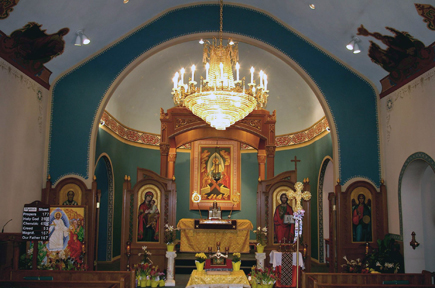
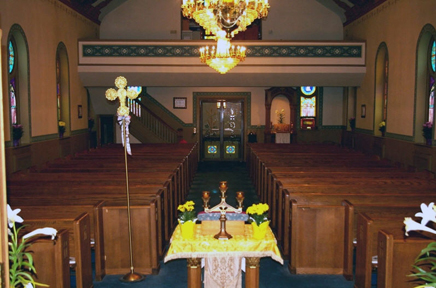
Cemetery Sign Photo Credit - TCC Web

Click Above go to "Our Churches" then to "St. Michael the Archangel - Allentown, PA"
Saint Michael’s Byzantine Catholic Church
Pittston, Luzerne County, Pennsylvania
Google Street Maps Image
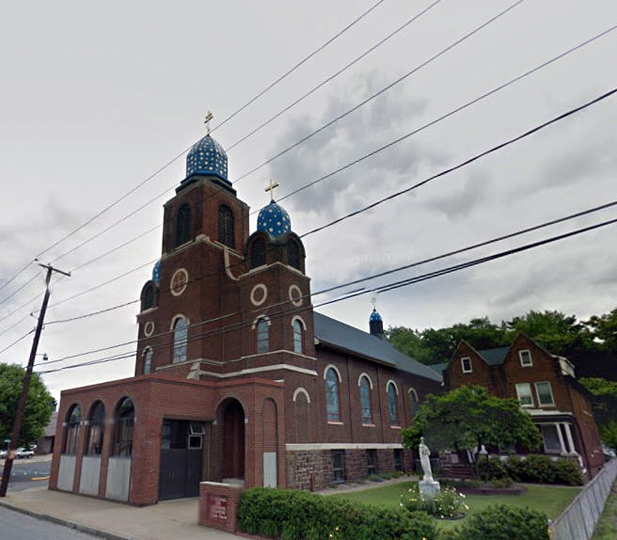
During 1911, immigrants from the former Austro-Hungarian Empire were moving to the Pittston area in search of employment. Pittston was well known as a coal mining area and there were an abundance of jobs in the mines. The city is large and was divided into three sections, the downtown (or center) the Oregon Section (south end) and the Junction (north end). At this time there was no Greek Catholic Church in Pittston. The Greek Catholic faithful desperately wanted their own church and a committee was formed. A meeting was held at the Bohemian Hall on North Main Street with Father Myron Volkay. The decision was made to begin a church so members could worship in their ancestral faith. During 1912, property was finally located at 205 North Main Street. After raising funds and making legal arrangements, the property was purchased for the sum of $5,000. The happiness of these devout Greek Catholic’s was endless. They immediately began construction plans and gave generously to pay for the costs required. Prior to the church being finished, Father Volkay celebrated Mass for the new congregation at Mount Carmel Roman Catholic Church in Pittston. Once the foundation and basement portions of Saint Michael’s were completed, parishioners attended Mass at the new location. The new basement was blessed and dedicated by Bishop Soter Ortinsky in 1915. Services were held in the basement until 1919 when the structure was completed. The church was magnificent and offered eight elegant stained glass windows and a beautiful altar that was not divided from the congregation by an iconostasis.
Anniversary Book Images
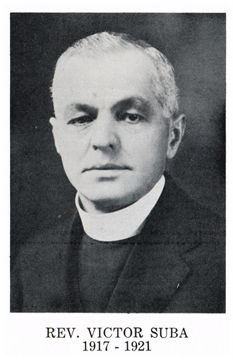
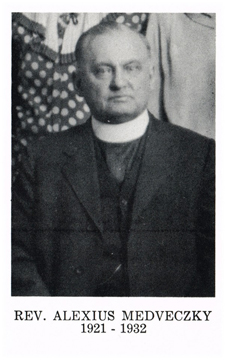
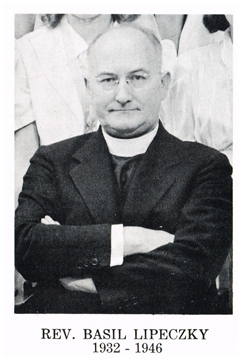
The first Mass in the new church was held on September 2, 1919 officiated by Father Victor Suba. In 1920, Monsignor Gabriel Martyak, Apostolic Administrator for the Ruthenian Greek Catholic Church in the United States, formerly dedicated the church. This was a never to be forgotten day. The parishioners finally saw their dream come true of having their own Greek Catholic house of worship. Improvements and expansions continued in the early years with the addition of a cemetery as a final resting place for the faithful. Father Victor Suba was assigned as the first full-time priest. He served the parish until 1921. Other clergy who served Saint Michael’s were Father Alexius Medveczky (1921-1932), Father Basil Lipeczky (1932-1946), Father (Later Monsignor and Vicar General of the Byzantine Catholic Eparchy of Passaic) George Durisin, Father Michael Warady (1946-1967) and Father *Sergius Bachkovsky (1967). Saint Michael’s also had a number of vocations to the priesthood and religious life. Three were Monsignor George Durisin and his sisters, Sister Paula (Anna) and Sister Philip (Rita) who entered the Sisters of St. Basil the Great Convent in Uniontown, Pennsylvania.
Saint Michael’s not only had residents of Landsford as parishioners but the faithful from other communities such as Dupont, Jenkins Township, West Side and Gouldsboro made the journey to worship there. As the parish expanded numerous groups and socieites began such as Saint Michael’s Rosary Society and a religious education program to teach children their faith. In 1963 an interior renovation was undertaken in honor of the 50th anniversary of the parish. The church was repainted and a modern electrical system was installed among other upgrades. The blessing and re-dedication of the church was held on August 1, 1965 with Bishop Stephen J. Kocisko. During the 1970’s a large portion of property was purchased. This was converted into a parking lot to accomdate parishiones who by this point were driving instead of walking to church. To prepare for the 75th anniversary, more upgrades were made and it was at this point a new altar and inconstanis were installed in the church. Also, modern conveniences such as central air conditioning were added along with exterior reinforcements to the church domes.
Seeing a need to conform with modern American society, the church began introducting more and more English into various services. Previously, all services had been held in Church Slavonic with limited English. Saint Michael’s Byzantine Catholic Church will celebrate their 100 years of existance on Sunday, November 1, 2015. At 3 pm an anniversary Liturgy will be held and later, a special banquet will be hosted by the church. To mark this exciting milestone, the church will hold special events throughout 2015 to commemorate this anniversary. Some functions scheduled will be various dinners and the annual flea market during the summer. From humble beginnings, overlooking the Susquehanna River, Saint Michael’s Byzantine Catholic Church has continued to florish. The dedicated parishioners look forward with happiness to the next 100 years when future generations will worhsip in their beloved church and faith.
Anniversary Book Images
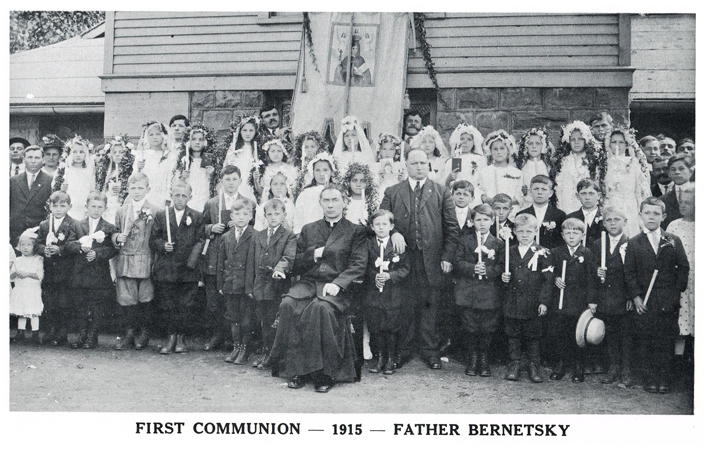
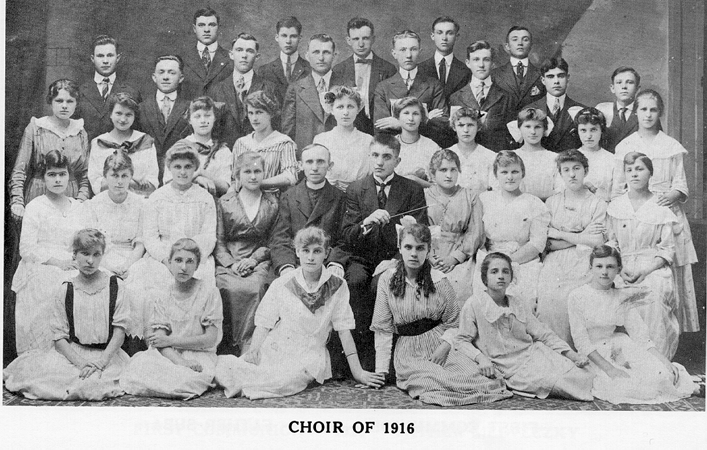
*Father Sergius Stephen Bachkovsky, O.S.B. was the son of Joseph Bachkovsky from the village of Stefurov, Slovakia and Mary Osifchin from the Carpatho-Rusyn village of Maly Lipnik, Slovakia.
Saint Nicholas Byzantine Catholic Church
Old Forge, Lackawanna County, Pennsylvania
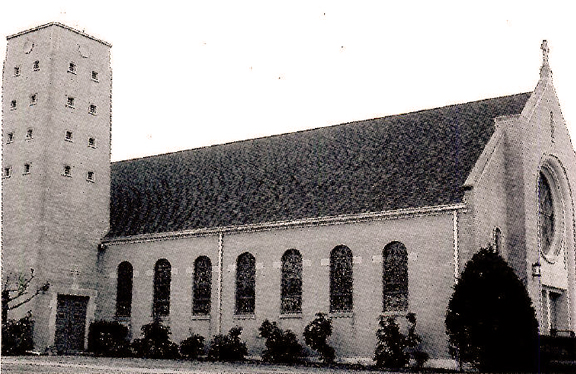
At the turn of the century, immigrants from the Austro-Hungarian Empire began settling in Old Forge and surrounding communities. The history of Saint Nicholas actually began with the establishment of Saint Michael’s Greek Catholic Church on Summer Street. Devout Greek Catholics banded together and started a church society. This society, “the Society of Saint Michael the Archangel” was formerly incorporated by the laws of the State of Pennsylvania on October 17, 1890. The goal of the society was to collect funds for the construction of a church, to unite the Greek Catholic faithful and to request that the bishop send a priest to serve the new congregations spiritual needs.
The parish was officially begun on July 14, 1891 and services were held at a parishioner’s home on Winter Street. During the beginning years, Father Alexander Shereghy served the parishioners needs. From 1891 to 1895, Father Nicephor Chanat was assigned to oversee the parish. Father Nicephor was the first resident priest of Saint Michael’s Greek Catholic (later Cathedral) Church in Passaic, New Jersey, he also was the administrator of Saint Michael’s in Old Forge. The choice of Father Nicephor for this new church was excellent. Born in Hungary, he was ordained a Greek Catholic priest in 1881. He was regarded as an outstanding scholar among his fellow clergy. He spoke Greek and was also fluent in Latin, German, French and his native Hungarian. Later, he mastered the English language. Father Nicephor was an excellent administrator and worked tirelessly to serve the needs of this beginning Greek Catholic church in Old Forge. Father Nicephor offered lectures for his parishioners to teach English and how to adjust to their new country. He worked tirelessly to build the new church in conjunction with this devoted parishioners.
After 1895, Father Valentine Balogh and Father John Zaklynsky (Pastor of Saint Mary’s Greek Catholic Church, Scranton) were assigned to Saint Michael’s which at this time was not fully constructed.
A few surnames of original founders for Saint Michael’s Greek Catholic Church were Constantine Rusyn, John Kopcho, Gregory Basalyga, Fillimon, Mitrofan, Basil and Roman Gambal, William and Harrison Krenitsky, Andrew Durniak, Jacob Korbelak, Peter Jadick, Joseph and Ignatius Stavisky, Simeon Hubiak, Thomas Dorosh, Myron Petrowsky and Paul Serniak. Along with these individuals was founder John Lischinsky. Mr. Lischinsky was born in 1863 in the Carpatho-Rusyn village of Hajtovka, present day Slovakia. He was baptized at Saint Dimitri’s Greek Catholic Church in Ujak (Udol), Slovakia. Mr. Lischinsky died in 1940 and was interred along with his wife Josephine (nee Orechovsky) at Saint Nicholas Byzantine Catholic Cemetery in Old Forge.
In 1896 Father Gregory Hrushka, a Ukrainian Greek Catholic priest who had immigrated to American from Galicia in 1889 was assigned as Saint Michael’s first pastor. During this period there were many ethnic and secular tensions within the parish. A segment of parishioners who were from Galicia instigated that the church should convert to Orthodoxy. Unfortunately, Father Gregory was misled into this confusion. He cast his lot with those who wanted to leave the Catholic faith and take the church with them. The entire congregation became embroiled in an issue of jurisdiction, to remain with their ancestral faith or, to convert to a new religion.
These tensions, along with Father Gregory’s support, came to a boiling point and in 1896, those who remained firm in their Greek Catholic faith broke away from Saint Michael’s. This was a heart wrenching decision. They had worked hard to build the church with their labor and financial support. Refusing to convert, they began a new church two blocks away on Church Street. This new church was placed under the protection of Saint Nicholas, the Patron Saint of the Greek Catholic Church. After these tensions began to wane, Father Gregory Hrushka returned to Galicia in 1913. He saw his mistake, repented and was reconciled back into the Greek Catholic church. He died in Galicia in the faith he was born into.
The loyal Greek Catholic parishioners lost no time in moving forward. They purchased property and constructed a new church which was blessed on September 26, 1897. A school was purchased from Saint Michael’s Roman Catholic Church and this was renovated for use as a Social Hall. Also, more land was acquired and set aside as a Greek Catholic cemetery. Father Andrew Symko served the new congregation for many years. The parishioners continued to work hard for their beloved church and the parish continued to grow. Later under the direction of Father George Durisin, a brand new parish center was constructed in 1952. By this time, it was evident the old church could no longer hold the large amount of parishioners. On May 20, 1956, ground was broken for a new church and rectory. Father Michael Dudick was assigned as the new pastor. On May 24, 1957 the new church and rectory were blessed. During his tenure, Father Michael (Later Bishop Michael Dudick) managed improvements to the cemetery which included the construction of a cemetery chapel. Saint Nicholas Cemetery Chapel was blessed by Bishop Nicholas T. Elko and the newly assigned pastor, Father Stephen Zajac.
Also, during 1957 a beautiful marble Virgin and Child statue was erected on the exterior church property. Donated by the Holy Name Society, it was dedicated to the memory of those parishioners who served in the armed forces defending the United States of America and made the supreme sacrifice. During Father Stephen’s tenure, an iconostasis was installed and renovations were made. A home in close proximately to the church was purchased and converted into a new religious education center. Father Michael Salnicky was assigned to Saint Nicholas in July of 1997. Father Michael was very hard working and oversaw the complete replacement of a new heating system and he implemented expanded religious education programs for adults and children.
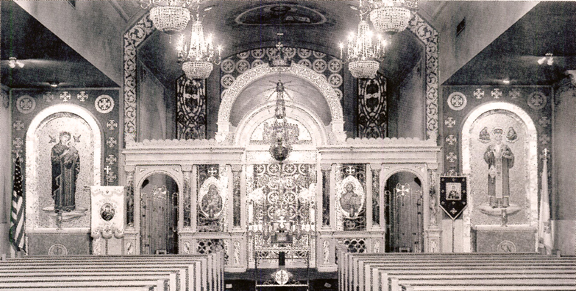
The interior of Saint Nicholas church is warm and inviting. Six spectacular chandeliers grace the ceiling, two stunning side mosaic altars, on the left of Our Lady of Perpetual Help and on the right of Saint Nicholas, adorn the altar. Above the choir loft is a circular stained glass window with vibrant colors and each side of the church has carved marble Stations of the Cross. Today, Saint Nicholas continues to be a vibrant and well attended church. Masses are held at 5 p.m. on Saturday night and 8:30 a.m. on Sunday mornings. Numerous events are held throughout the year such as bingo, flea markets, Chinese auctions and the annual Saint Nicholas dinner. These fund raisers for the church are always very well attended. After such sorrow during the beginning years, these devout Byzantine Catholics have risen above every obstacle. They are thankful that both former and current parishioners have worshiped in their ancestral faith for over 100 years. They continue to work hard and look forward to the next 100 years at their beloved Saint Nicholas Byzantine Catholic Church.
Saint Nicholas of Myra Byzantine Catholic Church
Pocono Summit, Monroe County, Pennsylvania
Photos Courtesy of Mrs. Kim Fedor
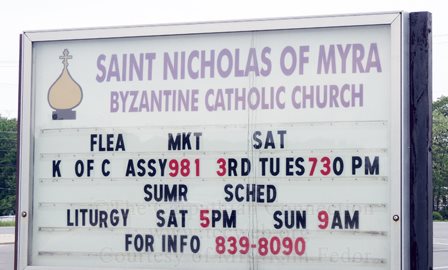
As Byzantine Catholics left urban areas for the suburbs, a number of families settled in the towns of Coolbaugh, Pocono Summit and Tobyhanna, Pennsylvania. During 1968 Eugene Simchak and Joseph Hametz were informed that Saint Mary’s Byzantine Catholic Church on Oak Street in Taylor, Pennsylvania would send a priest to serve the spiritual needs of Byzantine Catholics. Initially, a Liturgy/Mass was held at Saint Joan of Arc Roman Catholic Church in Mount Pocono, Pennsylvania. Saint Joan of Arc was begun in 1921 and was the closest Catholic Church available to hold services. The first Liturgy/Mass held at St. Joan’s was served by Father Sergius Bachkovsky. Father Sergius was a Benedictine Byzantine Catholic priest who later served as Prior of Holy Trinity Byzantine Catholic Benedictine Monastery in Butler, Pennsylvania. The founding family surnames for Saint Nicholas were Hametz, Polanchock and Smichak.
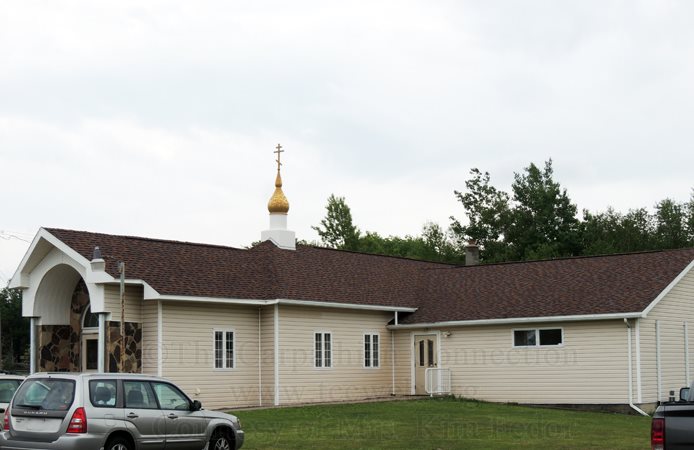
After ministering faithfully to the Byzantine Catholics of Saint Nicholas for many years, Father Sergius was transferred. Father Hal Stockert was assigned to serve the growing congregation. As news spread of this mission parish, more Byzantine Catholics in the region began attending services. In 1974 Monsignor Stephen Zajac was assigned to the mission parish. Sadly, Saint Joan of Arc suffered a terrible fire during this period. This was a cross road for these devout Byzantine Catholics. After much discussion, a decision was made to locate property and eventually have their own Byzantine Catholic Church. Pocono Summit is a small town within Monroe County. It was here that a community center was rented for services. Later, with the approval of Bishop Michael Dudick, this center was purchased and in 1976, the building was consecrated as Saint Nicholas of Myra Byzantine Catholic Church.
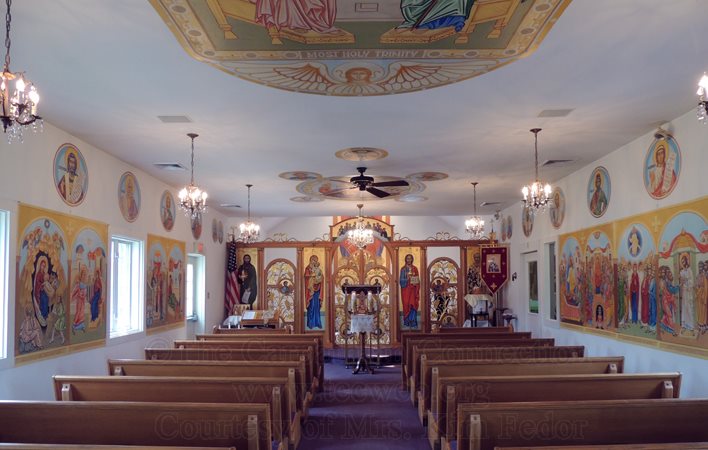
The parishioners worked tirelessly giving their talents and financial assistance to construct the church. The building was upgraded, a new heating system was installed and other interior/exterior renovations were added. A distinguished iconographer, Mrs. Mila Mina, was contracted to paint the interior of the church. Mrs. Mina was born in the Czech Republic and her husband was Byzantine Catholic. She studied at the Sorbonne in Paris and her focus became iconography. She has painted over 50 churches in the United States, Ukraine and the Czech Republic. Many in the United States were church interiors in the Byzantine Ruthenian Catholic and Romanian Greek Catholic churches. Some of her well known works are a Last Judgment, the Mysteries of the Holy Rosary and a stunning Stations of the Cross which adorn St. Mary’s Romanian Greek Catholic Church in McKeesport, Pennsylvania. She also painted the interior of Ascension of Our Lord Byzantine Catholic Church in Clairton, Pennsylvania where her son, Father Ivan Mina is the pastor. Mrs. Mina set to work and covered the interior of Saint Nicholas with exquisite icons in Carpatho-Rusyn style.
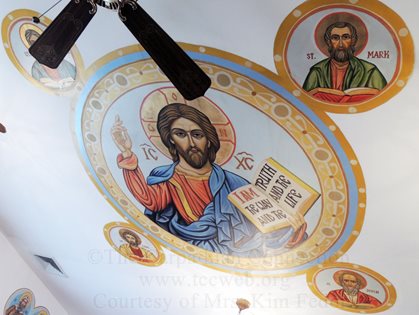
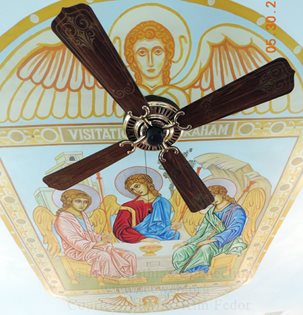
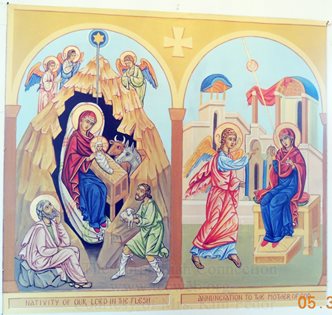
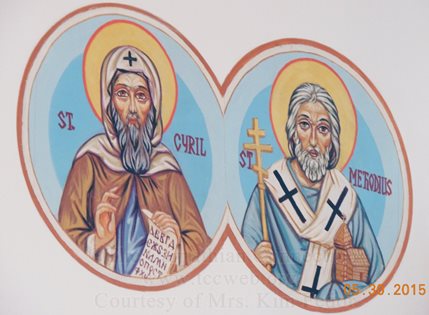
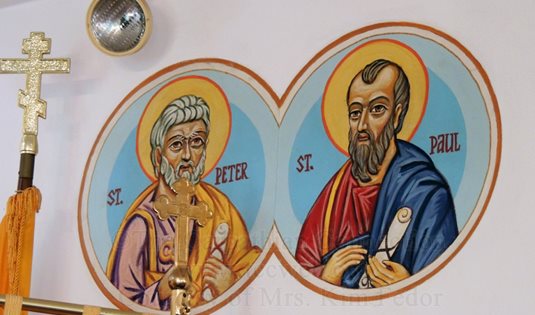
During this time, various priests provided their services to Saint Nicholas. Some were priests from the Byzantine Franciscan Monastery, Father Anthony Skurla (uncle of the present Metropolitan William Skurla), Father Basil Schott (later Metropolitan) and Father Marion Kawola. During 1980 the membership had grown and a larger church was necessary. Six acres of land in Pocono Summit were located and purchased. Amazingly, the entire church structure was placed on a flat-bed truck and relocated to the new property. As finances were vital to continue this project, a Saturday flea market was held in the church hall providing a large flow of income. Not far from the church was the Carpathian Village established by Bishop Michael Dudick. During the summer months of 1980 through 1995, seminarians from the Eparchy of Passaic came and assisted Monsignor Stephen Zajac and Father Paul Tigyer with liturgical services. In 1997 Bishop Andrew Pataki appointed Father Michael Slanicky as Administrator of Saint Nicholas.
Along with the church, upgrades were made to the social hall which included central air conditioning. Other additions were rooms for religious education classes, a large social hall and a fully modern kitchen for baking and cooking. The parking area was expanded and a large sign with the name of the church was installed. The parishioners of Saint Nicholas worked endlessly to support and expand their beloved parish. Some of the many projects the church sponsors yearly are Christmas and Easter baking sales, craft fairs and a flea market during the summer months. The membership of this vibrant parish has continued to increase. The love for the Byzantine Catholic faith is evident in how far this mission, which is now an established church, has come. A very welcoming parish, Saint Nicholas also began outreach programs in the community. This has made the Byzantine Catholic presence well known in the region.
For almost 50 years Saint Nicholas of Myra Byzantine Catholic Church has continued to flourish. At present, the church offers two Liturgies/Masses to accommodate the faithful, one at 6 p.m. Saturday night and one at 10 a.m. on Sunday morning. The dedicated parishioners today look forward with pride and joy to the future. Always mindful of the beginning days, they also recall all those in the past who sacrificed a great deal. These sacrifices have firmly established the Byzantine Catholic faith and Saint Nicholas of Myra Church in the Pocono Summit region.
Saints Peter and Paul Byzantine Catholic Church
Braddock, Allegheny County, Pennsylvania
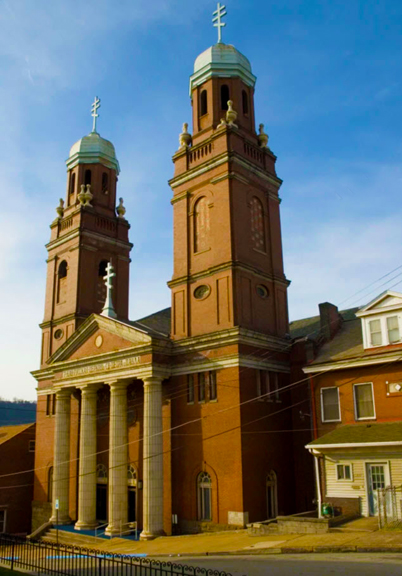
The borough of Braddock, Pennsylvania is located in the eastern suburbs of Pittsburgh. It was settled in 1742 and incorporated as a borough on June 8, 1867. General George Washington visiting the area 1753-1754 and industry began early. A large barrel plant was opened in 1850 and jobs expanded when Andrew Carnegie constructed the Edgar Thomason Steel Works on Braddock’s Field. Braddock was also the location for the first of Andrew Carnegie’s 1,600 plus public libraries. Designed by William Halsey Wood of Newark, New Jersey it opened on March 30, 1889. So that millworkers could use the library after work, a tunnel was constructed for Carnegie’s millworkers from the plant to a bathhouse so they could shower. At the turn of the century, thousands of immigrants arrived in this area as work was plentiful. They came from all regions of the former Austro-Hungarian Empire and were of many different ethnic backgrounds and various religions.
While there were Roman Catholic parishes such as Saint Michael’s Slovak Roman Catholic Church (1895) and Sacred Heart Polish Roman Catholic Church (begun in 1895, completed in 1897) there was no Greek Catholic Church. Initially, Greek Catholics attended the Roman Rite parishes. It was not long before a Greek Catholic Church was necessary. A group of Greek Catholic’s began the process of organizing a church. In May of 1896 plans were drawn up and the First Presbyterian Church on George Street was purchased. On August 29, 1896 the church was incorporated as Saints Peter and Paul Greek Catholic Church of Braddock. The church was officially dedicated on September 28, 1896 and Father Nicholas Szcetovich was installed as the first Pastor. The parishioners worked quickly and in 1900 a rectory was constructed. During 1914 a parochial school was built which operated until 1970. A section of plots were purchased in the Monongahela Cemetery for parishioners and a number of church pastors are interred there. A chapel was also constructed in this section of the cemetery. It is a simple design capped by a small tower with a belfry.
As was the case with many immigrant churches, Saints Peter and Paul grew quickly. It was not long before a larger church was required. After searching the area, property was found. Funds were available from the parishioners but they did not have an abundance. The Carnegie Steel Corporation of Bessemer, Pennsylvania purchased the old church property on George Street and demolished the building in December of 1920 for them. As is the case in Pittsburgh, many areas and roads are uneven. There are hills and inclines which make construction a challenge. This happened with Saints Peter and Paul Church. Between George and John Streets there was a 28 foot difference. The builders did a remarkable job and the church used Holy Cross Ukrainian Greek Catholic Cathedral in Uzhorod, Ukraine as a model.
Once completed, Saints Peter and Paul Greek Catholic Church was officially dedicated on November 2, 1924. An interesting aspect was on the location of the original church a print shop was constructed. This shop produced some of the most beloved prayer books and religious articles pertaining to the Byzantine Catholic Church in America. The shop was administered by Father Julius Grigassy from 1925 until 1959. Many of the faithful still have prayer books published from that location. The exterior of the church is an imposing sight. Made of red brick, it has four white pillars and the name of the church is engraved on top in Cyrillic. Originally, below the belfries each column was open. Currently, the right side tower is closed shut with bricks and the left side is partially bricked over. The church has a stone foundation and the towers are capped with two golden cupolas. The area where Saint Peter and Paul’s is makes up a residential/industrial based location and the church can be seen for miles.
The interior of Saints Peter and Paul Byzantine Catholic Church is breathtaking. There is no iconstansis and the open altar has a partial domed baldachino. The altar itself is of marble and there is a carved holy supper in front. The tabernacle is large. Inset with gold, a cherub and topped with a cross, it is surrounded by long singular candles, three on each side. Behind the altar is a round stained glass window of the Holy Trinity with two stained glass windows on the left and right. Behind the altar is a full length mural of Jesus Christ giving the Keys to Saint Peter. Both are flanked by angels and cherubim. Two red vicna lampada’s (eternal light) hang from each corner of the baldachino. The ceiling over the altar area is graced by the stunning image of God the Father in heaven flanked by angels. There is a statue of the Virgin Mary at the left front altar area and one of the Sacred Heart of Jesus to the right. Two statues of angels who are candle holders are to the left and right of the statues of the Virgin Mary and Sacred Heart of Jesus. Full length murals of the Stations of the Cross grace each side of the church. A brown wooden walk up pulpit is to the left of the altar. A carved marble baptismal font is also by the pulpit. The detail on this font is spectacular and it is topped by statues of Saint John the Baptist baptizing Jesus Christ.
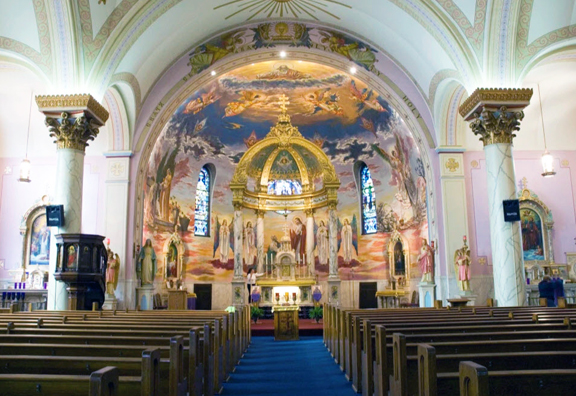
Two large side altars are to the far left and right of the altar. The left has a mural of the Virgin Mary with Jesus and the right side is of Saints Peter and Paul. Both have small tabernacles on them and were used, as was custom, years ago for various services. The preparation table to the left of the altar has a mural of Jesus Christ being shown his passion cup by an angel. The intricate marble scroll work with green, red, brown and gold colors are a masterpiece. Upon entering the church you are greeted by two life sized angels in pink and white holding large holy water fonts. Various candle stands and murals along with a large two bar cross adorn the entrance. On October 6, 1966 the church celebrated its 100th anniversary, the main celebrant was Metropolitan Judson Procyk. Saints Peter and Paul Byzantine Catholic Church has seen many changes over the years. The area is urban and distressed economically today. While services are down to one Mass each Sunday, the faithful are still very generous and devoted. The church holds various dinners and functions throughout the year. On August 20th 2018, the current Pastor Father Vitalii Stashkevych, a native of Uzhorod, Ukraine, was installed. He has worked hard to expand membership and offer as many services as possible. His “blessing of cars” as you drive past the church for Saint Elias day is very popular. Saints Peter and Paul has challenges like any church. However, just attending this resplendent house of worship with its elegant interior and 124 year atmosphere is enough to dazzle anyone. You cannot find this type of spiritual inspiration in other churches that are decorated currently in very anemic motifs. The parishioners of Saints Peter and Paul Byzantine Catholic church are very fortunate to have their church interior untouched for all to admire.
SS. Peter & Paul Byzantine Catholic Church
Lopez, Sullivan County, Pennsylvania
History & Photos
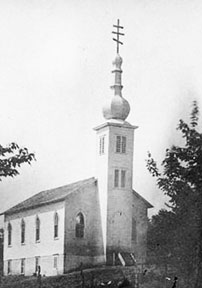
Prior to 1905 those in Lopez, Pennsylvania had no local Greek Catholic (in America re-named Byzantine Rite Catholic) church to attend. The mass migration of people from Eastern Europe seeking employment led many Slavic immigrants to the small town of Lopez, Pennsylvania. Lopez is a rural town, graced by lovely scenery, lush trees and is very mountainous. It is not surprising some Slavic immigrants came to this town. Lopez probably reminded them of their former towns and villages in Eastern Europe. Before Saints Peter and Paul was organized, individuals had to attend religious services in the nearby towns of Plymouth and Wilkes-Barre (which had a population of Slavic immigrants). Seeing a need for the families in Lopez, the priest of the Greek Catholic church in Plymouth organized families to build a church. Meetings were held and funds collected. By December 15, 1905 land was finally purchased for a church and cemetery on Church and Quarry Streets. It is to the credit of these immigrants that this church was built. It was an extreme financial hardship for them to gain the needed funding. After two long years of saving construction on the church started in 1907. Upon completion Father Nicholas Chopey of Saint Mary Church in Wilkes-Barre dedicated Saints Peter and Paul. The church was constructed in a white clapboard type design with one main cupola graced by a three-bar cross. The single column exterior, front main entrance style is small, yet very serviceable. The church rests upon an incline which progresses up a hill. This type of architecture is very common in many rural areas of various states. The simplicity of design made it popular and this guide was utilized for a Ukrainian Catholic church in neighboring Edwardsville, Pennsylvania.
By 1911 the church was expanding. The first Bishop for Greek Catholics in America of that period, Bishop Soter Ortynsky, made a pastoral visit to Saints Peter and Paul. It was during this visit that he re-dedicated the church. Due to this expansion in 1914 a much-needed rectory was constructed. Until this time the church had no full time priest to serve the parishioners. Finally, Father Cyril Perozok was named to serve the families of Saints Peter and Paul. This was an important event in the life of the church. More and more families who were Greek Catholic migrated to Lopez and the surrounding areas seeking employment. Since there was now a church of their faith and language Lopez became an attractive place to settle especially due to its rustic nature. With the establishment of a Greek Catholic church in Lopez there was no need to travel to the neighboring towns for religious services. The decision to reside in Lopez became very agreeable for some immigrants and the town saw an increase in its population.
Church Altar
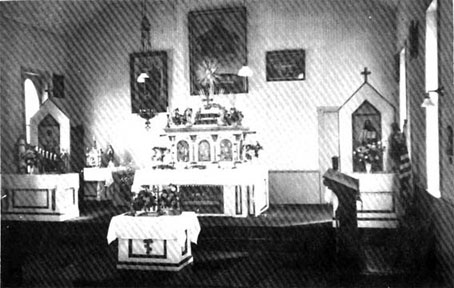 The church expanded rapidly and by the tenure of Father Andrew Ivanyshyn in 1915 Saints Peter and Paul had established a mission church in Sayre, Pennsylvania named Ascension of Our Lord. Father Ivanyshyn’s stay at Saints Peter and Paul was not that long but he did assist with the expansion of the altar, which included helping to hand-carve the main altar, and side altars, which adorned the interior. Many upgrades were completed during this period and Saints Peter and Paul became a fully operational Greek Catholic church. The church offered a school for its children, which taught religion along with language, and various customs, which their parents had brought, from the towns and villages of Eastern Europe. This school by 1924 had more than 50 students attending classes. Many priests had short tenures at Saints Peter and Paul and the last full-time priest to serve this congregation was Father John Ostap whose tenure ended in 1925.
The church expanded rapidly and by the tenure of Father Andrew Ivanyshyn in 1915 Saints Peter and Paul had established a mission church in Sayre, Pennsylvania named Ascension of Our Lord. Father Ivanyshyn’s stay at Saints Peter and Paul was not that long but he did assist with the expansion of the altar, which included helping to hand-carve the main altar, and side altars, which adorned the interior. Many upgrades were completed during this period and Saints Peter and Paul became a fully operational Greek Catholic church. The church offered a school for its children, which taught religion along with language, and various customs, which their parents had brought, from the towns and villages of Eastern Europe. This school by 1924 had more than 50 students attending classes. Many priests had short tenures at Saints Peter and Paul and the last full-time priest to serve this congregation was Father John Ostap whose tenure ended in 1925.
As time moved forward and with no full-time resident priest, Saints Peter and Paul saw many changes. Weekly Divine Liturgies were not held any longer and priests administered the church from various churches within the area of Lopez. From the 1940's onward many families left Lopez and older members were fewer in number. Those who still attended Saints Peter and Paul were devoted to their church and refused to give up. It is to the credit of these dedicated families that Saints Peter and Paul stayed in existence. During this time many churches in Pennsylvania were closing or merging with other larger congregations for survival. The cornerstone families of this church still hoped that Saints Peter and Paul would once again be a thriving church. Not to be deterred, the members still made renovations and made sure their churches upkeep was current.
Before 1993 a total of 73 priests had already served at Saints Peter and Paul, some as full-time priests, some as visiting priests, to hold services but the church still survived. In 1993 Father Michael Mokris was sent to Saints Peter and Paul as its administrator. Father Mokris re-instituted weekly Divine Liturgies for the members and began the church school once again. Due to the hard work of this priest and the members new families have joined Saints Peter and Paul and the membership has grown. Many important renovations were begun during these years, which were seriously necessary.
Main concerns to complete were a new roof and heating system for the church. Other renovations included the interior of the church and a new parking lot. The interior was upgraded and new icons installed. The Iconostasis is a low two-tiered style and is totally non-visual (the altar cannot be viewed through it without the Royal or Deacons doors being open). An icon of Christ the Teacher oversees the inside main altar and the altar itself is magnificent. A beautiful part of this altar is that it offers a relief at its base of the last supper. This today can only be found in older churches and is rare to find on modern American Byzantine Catholic altars. A small but exquisite chandelier graces the interior and the atmosphere are very devotional and inviting. Completing all the upgrades and renovations was difficult to do but was not impossible for the devout members of Saints Peter and Paul. These were massive financial projects for such a small church. The members worked tirelessly to raise the large sums needed to complete these undertakings. A recent project was the proposed purchase of sound system equipment for live radio broadcasts of the Sunday Divine Liturgy. These broadcasts were to have started on Sunday, September 5th, 1999 but, instead of hearing a celebration of the Divine Liturgy, a live tragedy would be seen instead of a broadcast.
Sadly, on Friday, September 3, 1999 Saints Peter and Paul church was totally destroyed by a massive fire. This jewel of church architecture and adornment, which for so long had served the faithful Greek Catholics of Lopez, was wiped out in a few hours. A funeral had been held at the church during the morning hours and shortly after, smoke was seen coming out of the church. The fire department was summoned and by the time of their arrival, smoke was pouring out of the bell tower and church itself. The fire was so enormous that the local fire department could not handle it. A total of 15 fire departments were called in for mutual assistance. It was ascertained later that the fire began near the altar area. The heat and fire were so intense that when the fire departments arrived, a stained glass window exploded. As with all fires and wooden structures, the fire progressed rapidly. It engulfed the entire building and spared nothing it its path. Finally, the flames consumed the top of the church and to everyone’s horror, the roof totally collapsed.
The firefighters worked frantically to save what they could of the church but their efforts were unfortunately in vein. After working so hard to save this church there was very little the firefighters could do. They felt as despondent as the people who observed this tragedy. After the blaze was contained the firefighters in their kindness entered the ruined church. They recovered a fire scared cross for which their efforts were truly appreciated by the members and those watching this terrible sight. Amazingly, the church bell did not fall during this inferno. The firemen rang this bell after the blaze was designated under control. Word spread of this disaster and priests and members of neighboring churches came to offer support. The fire department classified the church a total loss.
News of this event spread with local radio and television crews coming to Lopez for coverage of this terrible loss. Newspaper reporters also were dispatched to Lopez to cover the story. They interviewed members, local fire officials and others who had watched in horror as the church slowly was consumed by flames. The strong will of the members of Saints Peter and Paul were again tested but as always, they were ready for the task at hand. Members with their priest made swift plans. They posted a tent on the property to serve as a makeshift temporary church. Items for worship were loaned and given to them from the surrounding community churches. Not to be deterred, space was converted at the rectory to serve as a temporary chapel. After all that had taken place in a short span, the members of Saints Peter and Paul had overcome this tragedy. On September 8, 1999 Divine Liturgy was celebrated in their temporary chapel to commemorate a holy day. Support has been received from various places in the Lopez area and even towns that are far away have offered aid. As of this writing, Saints Peter and Paul is destroyed by fire but its members are not destroyed in spirit. If their past history is any gauge of what is to come, it will not be long before a new Saints Peter and Paul church will once again grace the town of Lopez, Pennsylvania.
.jpg)
.jpg)
Next to the church is the parish house. In 2017 the parish house was converted for use as a new church of the same name.
.jpg)
SS. Peter & Paul Byzantine Catholic Church
Palmerton, Carbon County, Pennsylvania
Photo Credit - 25th Anniversary Book 1914-1939
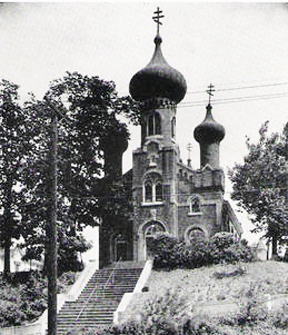
SS. Peter & Paul (Greek) Byzantine Catholic Church was founded by immigrants from Subcarpathian Rus’, during the formative years of the Borough of Palmerton. The size of the community grew and efforts to found a parish began in 1914. Initially an old school building at the corner of Franklin Avenue and Church Street was purchased and remodeled. Construction of the new church began in 1918, and SS. Peter&Paul (Greek) Byzantine Catholic Church was solemnly dedicated in June 1919.

The parish experienced a serious financial crisis after World War I. The construction cost of $62,000 was a tremendous burden for a small congregation at this time. In 1936 Bishop Basil Takach assigned the Palmerton church as a mission to St. Michael’s Church in Allentown. Fr. Stephen Gulovich was given the responsibility of reviving the parish spirit and its parochial life. Religious services at regular intervals, catechetical instruction and new organizations contributed to restoring the morale of the congregation. The faithful continued to sacrifice for the sake of their church, and necessary major repairs were completed as a result of their generosity. The church was redecorated then, blessed and rededicated in 1939.
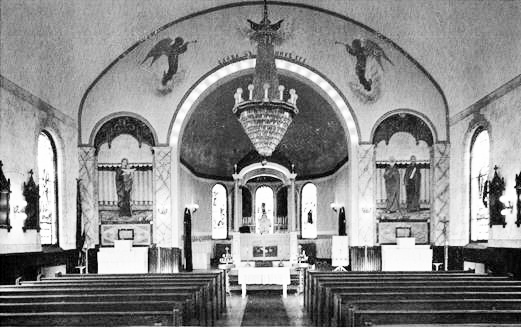
The architecture of SS. Peter and Paul's remains an outstanding feature of Palmerton to this day. The edifice features impressive exterior domes, triple onion with three-barred crosses a top, in a classic Carpatho-Rusyn architectural design. The church underwent interior renovation in 1996. The color scheme is red, tan and light tan. Two large mural icons grace the altar. On the left is the Nativity (birth) of Jesus Christ and on the right is the resurrection of Jesus Christ. Behind the altar property is a holy supper and above that is a mural of Christ Pantocrator. There is no iconostasis which is of great benefit to truly appreciate the entire beauty of this altar. There is a magnificent chandelier in the middle ceiling of the church and two murals of angels holding a chalice grace each side of the altar area.
With the decreasing membership in recent years, the parish returned to being a mission church of St. Michael's Byzantine Catholic Church in Allentown, twenty miles away.
As of 2014, the church is administered by Father Frank Hanincik. Of notable mention is a vocation from Saint Peter and Paul’s was the late Most Reverend Andrew Pataki, the third Bishop of the Byzantine Catholic Eparchy of Passaic.
Corporation Officers and Mother's Club 1939
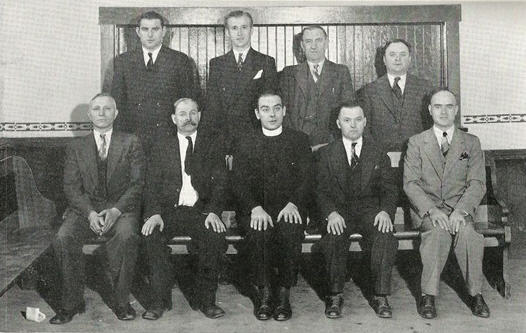
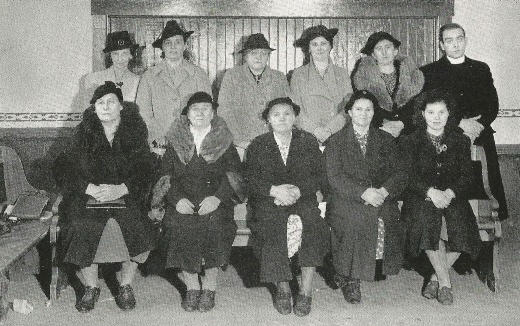
First Cathechism Class
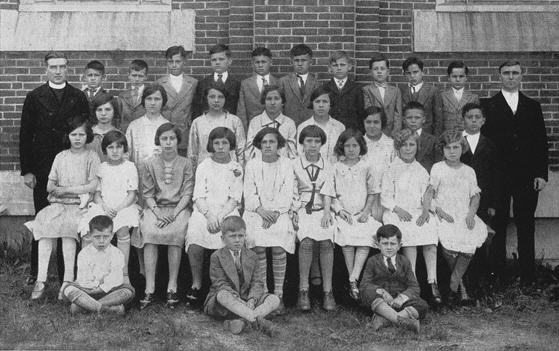
Orthodox
Saint Michael’s Orthodox Church
Old Forge, Lackawanna County, Pennsylvania
Church constructed after the 1903 Fire. Utilized from 1903-1965
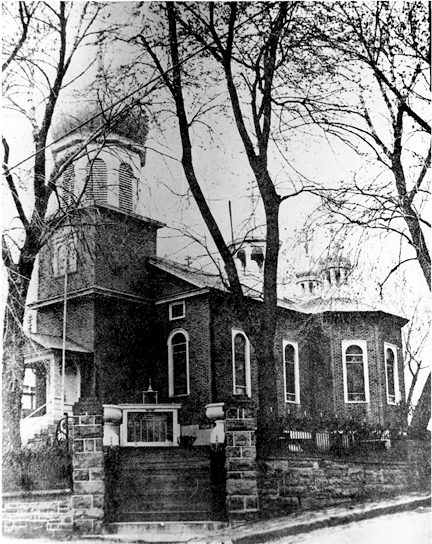
Saint Michael’s was organized by immigrants from the former Austro-Hungarian Empire. A number of the original parishioners came from Galicia (present day Southern Poland) where they are referred to as Lemkos. Being of the Greek Catholic faith, they wished to begin a church so they could worship in their ancestral religion. The town of Old Forge and surrounding areas offered an abundance of work in coal mines and silk mills. Once established with employment, the immigrants’ thoughts turned to their church. On October 17, 1890 the “Saint Michael the Archangel Society” was formed. The church began on July 14, 1891 as Saint Michael’s Greek Catholic Church and services were held at the home of a parishioner. Father Alexander Shereghy came and attended to the spiritual needs of the congregation. After Father Alexander’s death on November 15, 1894, Father Nicephor Chanat was assigned to oversee the church. Father Nicephor was the first resident priest of Saint Michael’s Greek Catholic (later Cathedral) Church in Passaic, New Jersey, he also was the administrator of Saint Michael’s in Old Forge. The choice of Father Nicephor for this new church was excellent. Born in Hungary, he was ordained a Greek Catholic priest in 1881. He was regarded as an outstanding scholar among his fellow clergy. He spoke Greek and was also fluent in Latin, German, French and his native Hungarian. Later, he mastered the English language. Father Nicephor offered lectures for his parishioners to teach English and how to adjust to their new country. He worked tirelessly to build the new church in conjunction with this devoted parishioners.
A few surnames of original founders for Saint Michael’s were Constantine Rusyn, John Kopcho, Gregory Basalyga, Fillimon, Mitrofan, Basil and Roman Gambal, William and Harrison Krenitsky, Andrew Durniak, Jacob Korbelak, Peter Jadick, Joseph and Ignatius Stavisky, Simeon Hubiak, Thomas Dorosh, Myron Petrowsky and Paul Serniak. Along with these individuals was founder John Lischinsky. Mr. Lischinsky was born in 1863 in the Carpatho-Rusyn village of Hajtovka, present day Slovakia. He was baptized at Saint Dimitri’s Greek Catholic Church in Ujak (Udol), Slovakia. Mr. Lischinsky died in 1940 and was interred along with his wife Josephine (nee Orechovsky) at Saint Nicholas Byzantine Catholic Cemetery in Old Forge. The parishioners donated their time, talent and finances. Saint Michael’s began to grow and the parish was flourishing spiritually and financially. Sadly, disunity began within the parish due to ethnic disagreements. The membership were split among Lemkos who originated from Galicia (present day Southern Poland) and Rusnaks from Hungarian territory (present day Slovakia and Hungary proper.) These tensions continued to smolder with the arrival of the first resident priest, Father Valentine Balogh. Father Valentine had been ordained a Greek Catholic priest in Hungary during 1864 by Julius Firczak, Greek Catholic Bishop of the Munkacs Diocese (established in 1439.) He was given his assignment on November 10, 1894 by the Roman Catholic Bishop of Scranton, Bishop William O’Hara. The Greek Catholic Church in America had no bishop and they were administered by the local Roman Catholic bishop. Father Valentine’s appointment was valid and fully approved.
Newspapers of this time period offer a very regrettable situation at Saint Michael’s. On Sunday, June 7, 1895, the Scranton Republican Newspaper reported keys to the church were withheld by those who wanted to change their religion. They prevented Father Valentine and the parishioners from entering Saint Michael’s. The newspaper also reported the defendants “threatened violence” if any attempt was made by plaintiffs to use the church for religious worship. The article went on to say these members sent the priest a notice “in Polish” basically stating they could no longer pay him and he had to leave. Father Valentine was given this note before entering the church to say Sunday Mass. The newspaper went on to report land for the church was purchased from the New York Susquehanna and Western Railroad Company. Money was collected throughout Old Forge, Taylor, Duryea, Rendham and Sibley by Polish and Hungarian Greek Catholic residents. As of 1895, the church had a membership of approximately 600 members with 150 being counted as “Polish” which, it would be assumed, were the members who originated from Galicia.
After trying to reason with the secession faction and being left no alternative, Father Valentine and the membership fought for the church. The Scranton Republican Newspaper reported on July 18, 1895 that equity litigation was instituted by plaintiffs, Father Valentine and the Greek Catholic members of his parish. The defendants in this matter countered with an injunction to obtain the property and were named as Kost Rusin, Roman Gambal, John Leschinski and eight others. Their position in the matter was to “disposes the congregation and exclude the pastor” from worshiping at the church. These were difficult days and the expanding court battle labored on. Claims and counterclaims followed, accusations were issued on both sides and one newspaper labeled this matter the “Old Forge Church War.” Hoping to quell inflamed emotions, Father Valentine was relieved and a new priest, Father Gregory Hrushka, was assigned as pastor of Saint Michael’s. Father Gregory was a Ukrainian Greek Catholic priest who immigrated to America from Galicia in 1889. He began his tenure but within a short span, he decided to follow the faction who wanted church control and to change their religion. It was during this juncture church construction was fully completed. Those who wanted to remain Greek Catholic requested Bishop William O’Hara’s assistance, however, when he arrived, the separating group forced him to leave. On December 25, 1896, those parishioners who decided to do so officially changed their religion to the Orthodox faith. The members who wanted to remain Greek Catholic left and constructed a brand new church, Saint Nicholas, on Church Street. The transition complete, the church was now labeled St. Michael Russian Orthodox Greek Catholic Church.
Upheaval did not end in these early years. The new parish was struck by disaster when, in 1903, the entire church and rectory burned to the ground. The loss of both buildings was estimated at approximately $7,000.00. Thankfully, the church was partially covered by insurance. A new church was constructed and this would last until 1965. After serving as pastor at Saint Michael’s and having gone through many trials and doubts, Father Gregory Hrushka returned to Galicia. It was there after much prayer and reflection, he recanted, was forgiven, returned to his ancestral Greek Catholic faith and died in 1913. Father Elias Klopotovsky was assigned as the next pastor of Saint Michael’s. During his tenure he worked hard to assist his parishioners’ needs both sacred and secular. During 1912 a new building was constructed which served as a rectory, educational classrooms and an auditorium. After all legal disputes were settled, the church was formally incorporated in 1924. Father John Kozitsky was assigned to Saint Michael’s in 1931 and he managed a remodeling program in preparation for the church 40th anniversary celebration. Metropolitan Platon officiated at the service of blessing of the newly renovated church. Saint Michael’s was the first American Orthodox church that saw one of its own elevated to Archbishop. Bishop Benjamin Basalyga was American born (January 11, 1887 in Olyphant, Pennsylvania) and was a member of Saint Michael’s. He was very skilled and prior to being ordained served as a choir director and church teacher in Charleroi and Pittsburgh churches until 1905. He became Bishop of Pittsburgh and West Virginia on September 9, 1933 and later became Archbishop of Toyko, Japan and Archbishop of Pittsburgh. During October of 1934, Father Joseph Pishtey was pastor of Saint Michael’s and a banquet honoring Bishop Benjamin was held in Saint Michael’s Auditorium.
During May of 1942 it was decided to upgrade the sanctuary and a new altar, tabernacle and other items which were hand crafted by Harry Witiak. A re-consecration service was held by Metropolitan Theophilus, Archbishop Arseny and Archbishop Benjamin. The golden jubilee of the church would have occurred in 1941, however, due to World War II, it was postponed and never re-scheduled. Father Damian Krehel was assigned as pastor and he served from 1935 until 1944. After Father Damian Father John Kiopistiansky was Saint Michael’s pastor. During his tenure Saint Michael’s again experienced sorrow. On June 23, 1952 another fire started in the auditorium and rectory. Both buildings were destroyed. The damage was estimated at $75,000.00 and for a time, the church was threatened. Fireman called for assistance to Scranton and the nearby boroughs. Finally, they succeeded in bringing the blaze under control. The parishioners of Saint Michael’s began immediately to rebuild at great expense and a new rectory was dedicated in April of 1954 by Archbishop Benjamin. In 1955 a new auditorium and school were constructed and were dedicated by Father Joseph Pishtey on behalf of Metropolitan Leonty. Sadly, on October 7, 1954, Father John Kiopistiansky suddenly died and his loss was greatly felt by the parishioners. Father Michael Dirga was assigned as the next pastor and he began many new programs at the church including an American based Sunday school program. Approximately 95 children were originally enrolled in the Sunday school with teachers from the parish.
The Ladies Club continued to work diligently at pierohi sales and other functions to help raise funds for the church. These dedicated women raised a large amount of finances for the parish throughout the years. Their pierohi’s were so popular that many factories and businesses in Old Forge, Taylor and Scranton would place orders of 50 to 60 dozen at a time. On Easter Sunday, April 9, 1961, Father Daniel Donovan, who had been assigned as the new pastor, announced to the happiness of all parishioners the church was totally debt free. A mortgage burning ceremony was held and overseen by Bishop Dimitri. At this juncture, a difficult decision had to be made. Saint Michael’s had served the faithful for many years, however, numerous costly repairs were required and could no longer be postponed. The decision was made to construct a new house of worship. It is to the credit of the dedicated members of Saint Michael’s the church was built. Some finances were saved as furnishings and the bells from the older church were transferred to the new church. A ground breaking service presided by Bishop Kiprian was held and the old church was demolished. Immediately contractors went to work constructing the new church. By the time it was finished, the cost was approximately $400,000.00.
The new church was consecrated in conjunction with the 75th anniversary of the parish. Bishop Kiprian was the main celebrant along with Father Vladimir Sovyrda who was the pastor. The parishioners continued to work hard paying off the $250,000.00 mortgage. Also at this time it was decided to pave the cemetery roads, install air conditioning in the church hall and remodel the rectory. These expenses added $170,000.00 to the church mortgage debt. Working constantly to repay this debt, the parishioners of Saint Michael’s are to be commended, they paid everything off within six years! Another major project was the improvements made during 1983. The Iconographer Rolf Rohn and Company of Pittsburgh, Pennsylvania were commissioned to paint numerous icons on the walls and ceiling of the church interior. This project was funded by the Ladies Club and the consecration of the icons and new altar was performed by Bishop Herman on July 29, 1990. Today, Saint Michael’s is still a vibrant parish. The entire cycle of services are observed and Liturgy is held each Sunday morning at 9:30 a.m. Numerous functions such as yard sales, dinners and an Easter Egg Hunt for the children are held. Requests for collections for Saint Tikhon’s Monastery Food Bank are always generously provided for by the parishioners. For over 100 years, Saint Michael’s Orthodox Church has been a presence in Old Forge, Pennsylvania. Her parishioners look forward to the future where the next generation will take up the work that was begun years ago.
